Yucatan's Bird-watching and Nature Tours
Hacienda Chichen Resort
Yucatan Bird Guide and Photos
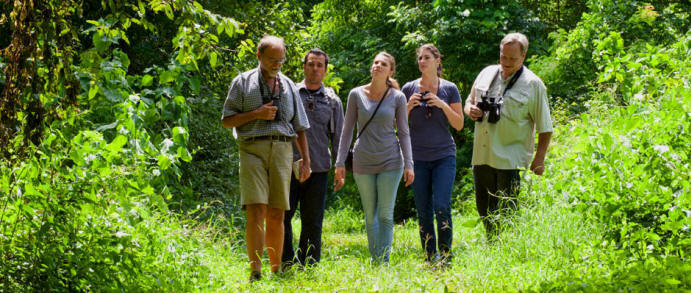
Bird-Watching Paradise and Eco-Cultural Destination:
Yucatan's Ecotourism and Responsible Sustainable Tourism at its Best!
At the Hacienda Chichen's Bird Refuge and Maya Jungle Reserve in Chichen Itza, Yucatan, Mexico, guests and visitors alike marvel at the beauty of Mother Nature's wildlife. Take a visual tour now of our Maya flora (plants) and Maya fauna (animals) and imagine what a great vacation you can enjoy at Hacienda Chichen, which is Yucatan's ideal bird-watching for both aficionado and professional birders.
The below "Full Bird List" is grouped in a manner that most bird lovers will understand rather than in a scientific family format; should you observe at the Hacienda Chichen Resort an additional family or species not mentioned here, please contact us to include it; plus, if you can send your photo it will be great, thanks!
Yucatan Bird Guide: list of birds found at Hacienda Chichen
Chichen Itza, Yucatan, Mexico
Anis & Cuckoos Bunting Birds Cardinals & Grosbeak Currasows & Guans Doves & Pigeon
Egret Euphonia & Finches Falcons & Caracaras Flycatchers Galliforms Grackles & Cowbirds
Gnatcatchers & Grassquits Hawks & Goatsucker Birds Hummingbirds Jay Birds Mocking Birds
Motmot Birds Orioles Owl Birds Parrots Plovers Quails Sparrows Swifts
Swallows & Thrushes Tanagers Tinamous Tityra & Becard Tucans Turkey Trogons
Vireos Vultures Warblers Waxwings Woodpeckers & Woodcreepers Wrens
Yucatan Endemic Birds Black-birds ID
Birding in Yucatan at Hacienda Chichen is quite a joy, over 157 wild bird species are found in this green hotel's Bird Refuge and gardens; among these wild bird species found in this region, you can also observe the following endemic birds, which the Hacienda Chichen Resort protects within its Bird Refuge and grounds. Birding for any guest as well as for true professional birders is very rewarding; for photographers this is truly a wonderful opportunity to shoot great photos. Also if you are an amateur birder, you can booked a Mayan Local Bird-watching guided tour with one of our Maya local guides who help birders identify birds as well as Mayan medicinal plants during the 90 minutes bird nature guided tour, offered at Hacienda Chichen, Chichen Itza, Yucatan.
At Hacienda Chichen gardens and Bird Refuge bird-watching is one of the highlights moments of most guests visiting this magnificent Mayan region. For Yucatan birding activities and birding tours in the Yucatan, please contact Hacienda Chichen Resort via email.
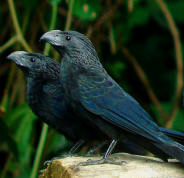 Ani and Cuckoos: Ani and Cuckoos:
Ani Groove-billed, Crotophaga sulcirostris, called "Chic Bul" or "Ch'ikbu'ul" in Maya, is a tropical black bird in the cuckoo family that resides at Hacienda Chichen Bird Refuge most of the year. It has black-shiny plumage, deep horizontal grooves along its strong wide beak, strong mandible and a really long long tail. Normally, the Ani Groove-billed is observed in small pair groups in open pastures and orchards. Territorial, the group feeds mainly of insects, seeds, and round forager. Ani Groove-billed lay their eggs in one communal nest placing it in tall trees with all group members incubating the eggs and caring for the young. Order: Cuculiformes / Family Cuculidae.
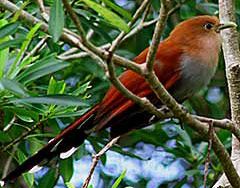
Squirrel Cuckoo, Piaya cayana, called "Kip Cho" in Maya, cayana (Kip Cho in Maya), a rather large bird averaging 46 cm long. A shy bird is found in woodlands and semi-open jungle hedges. Squirrel Cuckoo birds fly only short distances, leaping from branch to branch feeding on large insects such as spiders, caterpillars, wasps, and sometimes fruit. Squirrel Cuckoo plumage has a cinnamon or chestnut upperparts covering the top head, then paler on the throat with an almost pink tone. Its lower breast and belly are grayish. Squirrel Cuckoo's long tail feathers have black with white band-like tips. The bill is lime and the iris is red. These beautiful birds are fairly large in size and their call has sharp "kip! weeuu sounds with long wheeps whistles. Females lay 2 or 3 eggs on twit-leaves high nests.
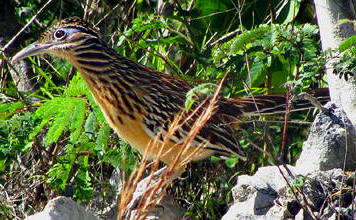 Lesser roadrunner, Geococcyx velox – is a commonly solitary bird but it may live in pairs. A member of the Cuckoo family Cuculidae, order of Cuculiformes. The Lesser roadrunner has a dove-like "coo" vocalization. It resembles in appearance and in its ground foraging habits to the Greater Roadrunner, Geococcyx californiana; but it is smaller, has a shorter bill, long tail, slender long legs, black-golden brown and white streaked plumage. Its head features a patched of bluish bare skin behind its bulky eyes. Although capable of flying, this is a terrestrial bird that eats seeds, fruit, insects, small reptiles such as snakes, lizards and frogs. Forages around roadsides in arid lowland and scrub for its food and occasional road-kill. Lesser roadrunners can run up to 20 miles an hour. Breeding nests care placed in a low bush or cactus. They have bi-parental care to their young. There is a disjoint range, restricted island population, of Lesser roadrunners found in the North of Yucatan Peninsula. Lesser roadrunner, Geococcyx velox – is a commonly solitary bird but it may live in pairs. A member of the Cuckoo family Cuculidae, order of Cuculiformes. The Lesser roadrunner has a dove-like "coo" vocalization. It resembles in appearance and in its ground foraging habits to the Greater Roadrunner, Geococcyx californiana; but it is smaller, has a shorter bill, long tail, slender long legs, black-golden brown and white streaked plumage. Its head features a patched of bluish bare skin behind its bulky eyes. Although capable of flying, this is a terrestrial bird that eats seeds, fruit, insects, small reptiles such as snakes, lizards and frogs. Forages around roadsides in arid lowland and scrub for its food and occasional road-kill. Lesser roadrunners can run up to 20 miles an hour. Breeding nests care placed in a low bush or cactus. They have bi-parental care to their young. There is a disjoint range, restricted island population, of Lesser roadrunners found in the North of Yucatan Peninsula.
Bunting Birds:
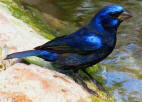 Blue Bunting, Cyanocompsa perellina, belongs to the passerine bird species. Small stocky bunting with a stout black bill. Males have deep dark blue plumage with bright highlights; females have warm brown plumage and slightly paler belly. They forages on ground, in thickets, and in bushy areas. Blue Bunting, Cyanocompsa perellina, belongs to the passerine bird species. Small stocky bunting with a stout black bill. Males have deep dark blue plumage with bright highlights; females have warm brown plumage and slightly paler belly. They forages on ground, in thickets, and in bushy areas.
ID -Order: Passeriformes / Family: Cardinalidae.
Indigo Bunting, Passerina cyanea, showcases deep turquoise indigo blue plumage all over with a black mark in front of eyes, when in mating season (male photo below); this beautiful indigo song-bird is found in Hacienda Chichen during its migratory winter season (Nov. to March each year); prefers undisturbed lush forest areas and rejoyadas. You can observe Indigo bunting birds stroll gently through the hotel's Maya Jungle Reserve. Indigo Buntings migrate at night, using the stars for guidance, they learn their night sky orientation as young birds. The female plumage has pale brown upper feathers (image below). Male Indigo Bunting are similar to the Blue Grosbeak, also found at Hacienda Chichen.
Painted Bunting, Passerina ciris, males have a distinctive combination of plumage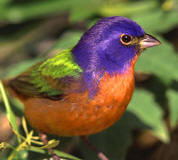 colors: bright red fro the bottom of the peak to the belly and tail; the back has bright metallic hues of green, while the head blends deep indigo blue with violet tones, plus a red circle eye-line. This beautiful bird is a permanent resident in the Maya Jungle Reserve in Chichen Itza, Yucatan, Mexico. Passerine ciris female bird has a pale brown back and yellow/green belly. They inhabit mid - low scrubland and forest. Shy, reproduces near water areas in wood dense wild sites. Feeds on seeds, small fruits, and some insects. At the Hacienda Chichen Bird Refuge it is seen near the pool area. colors: bright red fro the bottom of the peak to the belly and tail; the back has bright metallic hues of green, while the head blends deep indigo blue with violet tones, plus a red circle eye-line. This beautiful bird is a permanent resident in the Maya Jungle Reserve in Chichen Itza, Yucatan, Mexico. Passerine ciris female bird has a pale brown back and yellow/green belly. They inhabit mid - low scrubland and forest. Shy, reproduces near water areas in wood dense wild sites. Feeds on seeds, small fruits, and some insects. At the Hacienda Chichen Bird Refuge it is seen near the pool area.
.
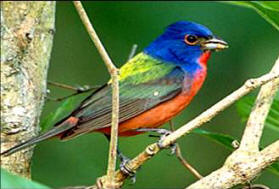 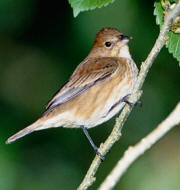 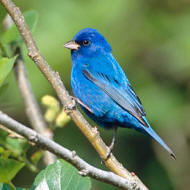
PAINTED BUNTING - Male INDIGO BUNTING - Female INDIGO BUNTING - Male
BACK TO BIRD GUIDE LIST
Cardinals and Other Grosbeaks:
 Blue Grosbeak, Passerina caerula formally Guiraca caerulea. Blue grosbeak birds are in the Northern Cardinal grosbeak "tropical" family. A passerina migratory bird that forages on the ground and shrubs eating insects, grains and fruits. Found in partly open habitat and overgrown fields, this beautiful bird nests in low bushes and can be found feeding on seeds and wild grassy edges. Blue Grosbeak, Passerina caerula formally Guiraca caerulea. Blue grosbeak birds are in the Northern Cardinal grosbeak "tropical" family. A passerina migratory bird that forages on the ground and shrubs eating insects, grains and fruits. Found in partly open habitat and overgrown fields, this beautiful bird nests in low bushes and can be found feeding on seeds and wild grassy edges.
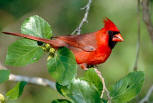 Northern Cardinal, Cardinalis cardinalis, called "Chak Is'iits'ib" in Maya. These breathtaking deep bright red songbirds are loved for their beautiful singing notes and familiar shade of red (males) with black face marks. Females have brown plumage with same sharp crest and show warm red accents. Northern Cardinal, Cardinalis cardinalis, called "Chak Is'iits'ib" in Maya. These breathtaking deep bright red songbirds are loved for their beautiful singing notes and familiar shade of red (males) with black face marks. Females have brown plumage with same sharp crest and show warm red accents.
Other Grosbeaks Birds:
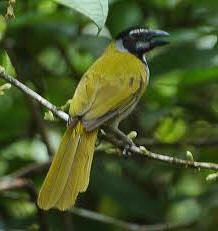 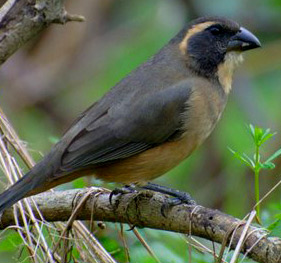 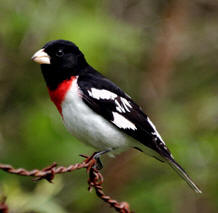
Black-headed Saltator - male Grayish Saltator - male Rose-breasted Grosbeak - male
Saltator coerulescens Saltator coerulescens Pheucticus ludovicianus
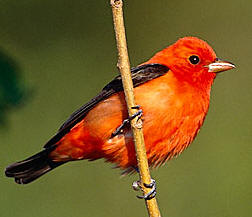 Scarlet tanager, Piranga Olivacea, "Chac yuyum" in Maya, formally classified in the tanager family Thraupidae now within the genus of the Cardinal family Cardinalidae. Scarlet tanager's plumage and vocalization are similar to the cardinal songbirds. Adults males plumage is bright scarlet red with black wings and tail, while scarlet females have yellowish underparts, olive tops, brown wings and tail. Juvenile scarlet birds show complex variegated plumage. They breed in May and stay till October foraging high in tree tops. Eat insects in flight but enjoy small berry fruits, building their nests in horizontal high branches. Scarlet tanager, Piranga Olivacea, "Chac yuyum" in Maya, formally classified in the tanager family Thraupidae now within the genus of the Cardinal family Cardinalidae. Scarlet tanager's plumage and vocalization are similar to the cardinal songbirds. Adults males plumage is bright scarlet red with black wings and tail, while scarlet females have yellowish underparts, olive tops, brown wings and tail. Juvenile scarlet birds show complex variegated plumage. They breed in May and stay till October foraging high in tree tops. Eat insects in flight but enjoy small berry fruits, building their nests in horizontal high branches.
BACK TO BIRD GUIDE LIST
Currasows and Guans:
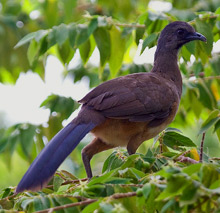
Plain chachalaca, Ortalis vetula, called Baach in Maya, is a massive large bird in the Cracidae family. Plain chachalaca birds have long necks, bare throat, small heads and really long tails. This bird species enjoys feeding on the ground fruits, seeds, leaves, and flowers. Gliding and leaping through brushy vegetation, plain chachalaca birds often call with a loud rhythmical chorus early mornings and evening, many times producing peeping whistles and cackles that mimic blabbing chatting loud sounds. They breed in early June and their nests look like a shallow saucer made of twigs, plant fibers and leaves. Plain chachalaca birds are shy and difficult to view in the open but easy to hear from a far during the early morning even in the hotel gardens.
BACK TO BIRD GUIDE LIST
Doves and Pigeons:
There is no difference between a pigeon and a dove besides the fact that pigeon is a word that comes from the French "pijon" and "dove" s the in English name for birds of the Columbidae family which includes over 300 species of near-passerine birds worldwide. However, nowadays we commonly refer to "doves" to the small members of the species and to "pigeons" to the larger ones; this practical tendency is also found in ornithology. Pigeons and doves pair for life and their singing has a very low resonant note pattern with little variations; they typically counter sing with group members creating enthusiastic patterns. The following doves and pigeons are found at Hacienda Chichen Bird Refuge in Chichen Itza, Yucatan, Mexico. You can observe most of these doves and pigeons, called "Mucuy" in Maya, at the hotel's main garden and in our many ficus trees and paths all year:
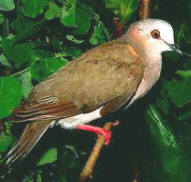 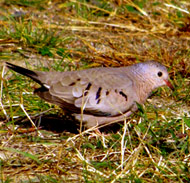 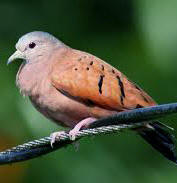 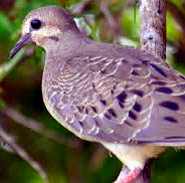
Caribbean dove Common ground dove Ruddy ground-dove Mouring dove
Leptotila jamaicensis Columbina passerine Columbina talpacoti Zwnaida macroura
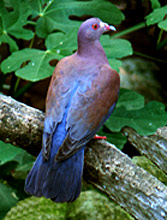 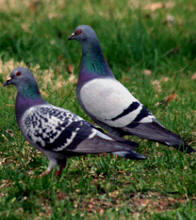 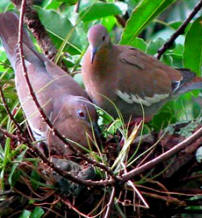 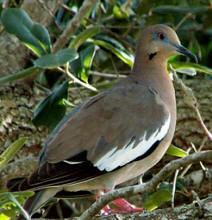
Red-billed pigeon Rock pigeon - couple White tipped dove White winged dove
Patagioenas flavirostris Columba livia Leptotila verreauxi Zenaida asiatica
BACK TO BIRD GUIDE LIST
Egret:

Cattle Egret, Bubulcus ibis, a small gregarious snowy-white egret distinguished during breeding season by its orange crown plumes. This ibis has long neck and long yellow pinkish bill that turns reddish during breeding season; when they monogamous pair within breeding colonies. The Cattle Egret normally legs also change color during breeding season from gray-green tones to bright red to orange-brown colors. This bird species is commonly seen foraging and grazing stock in wetlands and interior grassy pastures. Cattle egrets love to eat grasshoppers and insects as well as worms, ticks, small frogs and lizards.
Euphonia and Finch Birds:
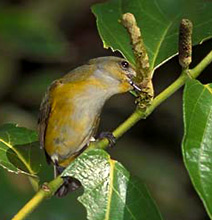 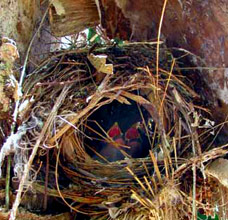 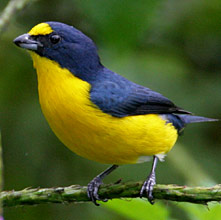
Yellow-throated Euphonia female (left) breeding nest (center photo) male (right) Euphonia hirundinacea
Yellow-throated Euphonia Euphonia hirundinacea belong to the Tanager Subfamily, the Thraupinae. This stocky small birds are found all year round at Hacienda Chichen Resort's gardens in Chichen Itza, Yucatan, Mexico. Its natural habitats are subtropical dry or moist lowland and disturbed forests. Note the yellow throat plumage is what distinguish this Euphonia male from the Scrub Euphonia male that has a black throat plumage. Both parents care and feed their young.
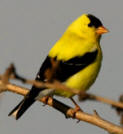 Lesser Goldfinch or Dark-backed Goldfinch, Carduelis psaltria, is a social small seed eating finch, often gregarious and enjoys living in small flocks. It is among the most joyful songbird found year round in Hacienda Chichen Bird Refuge. It has a small pointed and conical dark bill, dark wings with large white wing-bars and short notched tail. Lesser Goldfinch males have bright yellow body plumage with black backs, cap and wings, though some have dirty green back plumage. Very adaptable to open habitat settings and forest clearings, it primarily feeds in small groups moving through low weeds and seeds. Pairs are monogamous, females wove and line their cup-like nests and the male feeds the female when she is incubating eggs. Due to their lovely singing they get caught for the cage bird trade by Maya locals but they are protected at Hacienda Chichen Bird Refuge and Maya Jungle Reserve. Lesser Goldfinch or Dark-backed Goldfinch, Carduelis psaltria, is a social small seed eating finch, often gregarious and enjoys living in small flocks. It is among the most joyful songbird found year round in Hacienda Chichen Bird Refuge. It has a small pointed and conical dark bill, dark wings with large white wing-bars and short notched tail. Lesser Goldfinch males have bright yellow body plumage with black backs, cap and wings, though some have dirty green back plumage. Very adaptable to open habitat settings and forest clearings, it primarily feeds in small groups moving through low weeds and seeds. Pairs are monogamous, females wove and line their cup-like nests and the male feeds the female when she is incubating eggs. Due to their lovely singing they get caught for the cage bird trade by Maya locals but they are protected at Hacienda Chichen Bird Refuge and Maya Jungle Reserve. 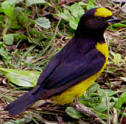
Scrub Euphonia, Euphonia affinis, order Passeriformes, Family Carduelidae. Scrub Euphonias are truly social gregarious tiny birds. Males have a blue black head, upperparts, wings and neckline with bright yellow fore-crown and under-parts. Females have a duller pale yellow belly and greenish gray upper plumage. It has a variety of habitats but is commonly found in our scrubby woodland and royal palms when they produce their small fruits. Scrub Euphonias make different calls with double and tripled dee or deen notes. They often mixed with other bird species near trees that are baring fruits.
BACK TO BIRD GUIDE LIST
Falcons and Caracaras:
Caracas are raptors (birds of prey) in the Family Falconidae, members of the true falcon subfamily subfamily Falconinae found principally in South America, Central America and the south region of USA. Caracaras are often scavengers and falcons are aerial hunters, both are carnivorous. These are the caracaras and falcons found at Hacienda Chichen Maya Jungle and Wildlife Reserve:
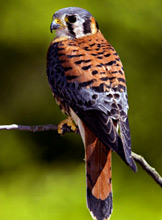 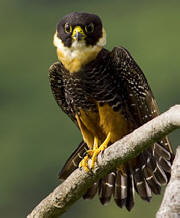 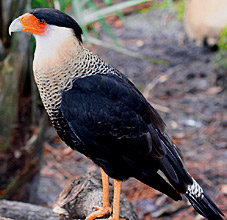
American Kestrel Bat Falcon Crested Caracara
American Kestrel, Falco sparverius, called I'kos in Maya, are the smallest falcons observed at Hacienda Chichen Wildlife Reserve as winter visitors. Males have truly attractive facial feather patterns with a blue-gray crown and white with black throat bands; their back wings have golden brown plumage with black spots and their wings long blue-gray feathers, their tail under-parts have black and golden brown bands ending with a white tip (see above left photo). Females are similar in size but their plumage is less colorful with mostly golden brown and dark brown body spots and bands. Adapted to various habitats, American Kestrel hunts by perching or hovering for small pray typically lizards, mice and small animals. Nests in tree cavities and both parents help incubating and feeding their offspring.
Bat Falcon, Falco rufigularis a small bird of prey and resident breeder that can be observed in forest clearings or perching conspicuously on high open dead tree branches from where they launch their aerial attacks to their pray such as bats, birds, and large insects. Females are larger than males. Adults have a black head, back, and tail; the throat and upper chest are creamy white with fine barred white bellies. Has a distinctive high pitched call.
Crested Caracara, Caracara cheriway, also called Northern Crested Caracara. A slow flying falcon found in most of Mexico, Cuba and Central America, truly voracious omnivorous scavenger found in semi-open country habitats. It enjoys carrion but eats on ground small mammals, insects and reptiles. Males have broad wings, long tail and legs; frequently found walking and running on ground. Sexes are similar in size and plumage, with black long feathers a top of the head, bright orange cere or facial skin, and hooked white bills.
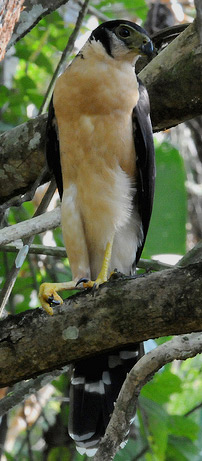 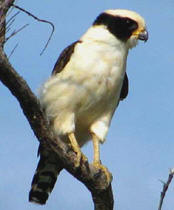  
Laughing Falcon Peregrine Falcon Crested Caracara
Collared Forest Falcon, Micrastur semitorquatus, (extreme left photo) is the largest member of its genus. You will find it in the wild within Hacienda Chichen Maya Jungle Reserve grounds; this falcon has face mask, yellowish legs and dark tail with light bars.
Laughing Falcon, Herpetotheres cachinnans (Kos in Maya)a Neotropical falcon species of the subfamily Polyborinae that enjoys mostly eating snakes. His call is an unmistakable laughing aloud sound. As with most birds of pray, this falcon's female is bigger than males. Adults have pale buff head with a broad black face mask across neck; it has white body plumage and a banded tail with black brownish wings. Prefers humid semi-open habitats.
Peregrine Falcon, Falco peregrinus, a great hunter from the family Falcomidae that preys on birds and bats in mid-flight (speeds over 200 mhp). This large crow sized falcon mates for life and prefers wide open spaces. It has beautiful barred white under-parts and a black head band over his eyes and a banded tail. Winter visitor to Hacienda Chichen Bird Refuge.
BACK TO BIRD GUIDE LIST
Flycatcher and Antbirds:
Flycatcher family of birds from the order of Passeriformes. Many flycatchers are great songbirds and truly have a beautiful plumage. This large group of birds includes various species, all of which feed mainly on insects that are caught during fly, many feed also on small fruits or berries. Flycatchers have incredible aerial skills and spend time perching on various territories and habitats. These are the flycatchers found at Hacienda Chichen Bird Refuge and Maya Jungle Wildlife Reserve, in Chichen Itza, Yucatan, Mexico:
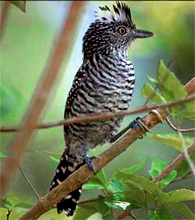 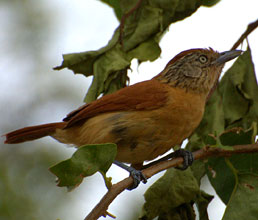 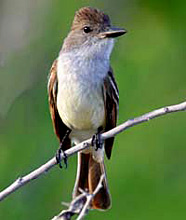
Barred antshrike - male Barred antshrike - female Brown-crested flycatcher
Thamnophilus doliatus Thamnophilus doliatus Myiarchus crinitus
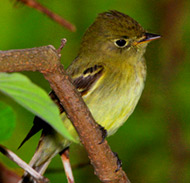 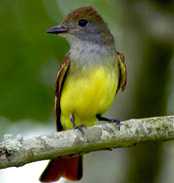 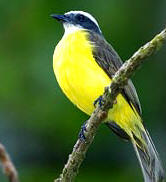 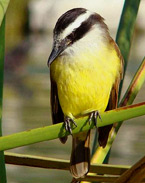
Yellow-bellied Flycatcher Great crested flycatcher Social Flycatcher Great Kiskadee
* Barred antshrike, Thamnophilus doliatus, is a non-migratory territorial antbird found at Hacienda Chichen Bird Refuge, enjoys dense scrub areas in secluded paths. Sexually dimorphic songbird, male has a striking plumage alternating black and white bars all around its body and features a distinctive black feathered head crown; females have a cinnamon-rufous upper plumage with an ocher body tone and stripped head plumage. Both have strong large bills and live as pairs, producing duet long songs during breeding; incubate two purple marked eggs. Feed on insects and follow ant swarms. (photo above*)
Boat-billed flycatcher, Megarynchus pitangus - it is named X'takay in Maya as all birds with similar head and body plumage colors. Boat-billed flycatcher, are the largest species of the tyrant flycatcher and the only member (monotypic) of the genus Megarynchus. Breeds near the front of Hacienda Chichen open gardens with tall trees; its nest is built with sticks in a saucer shape by the female for the incubation of two or three eggs. Its large bill helps bird-lovers distinguish it from the Great Kiskadee which has similar plumage. Feeds on insects, small invertebrates and ficus berries.
 * Bright-rumped attila, Attila spadiceus, has a variable olive brown plumage but its streaking yellowed belly end and obvious dark brown wings with two pale wing-bars help birders identify it. A small tyrant flycatcher It perches while singing and prefers shady garden areas; eats insects as well as seeds and berries. Nests in the quiet areas of Hacienda Chichen property, building deep cups of mosses, leaves and soft pochote fiber, incubates two pale lilac marked light pink eggs. *left photo * Bright-rumped attila, Attila spadiceus, has a variable olive brown plumage but its streaking yellowed belly end and obvious dark brown wings with two pale wing-bars help birders identify it. A small tyrant flycatcher It perches while singing and prefers shady garden areas; eats insects as well as seeds and berries. Nests in the quiet areas of Hacienda Chichen property, building deep cups of mosses, leaves and soft pochote fiber, incubates two pale lilac marked light pink eggs. *left photo
* Brown-crested flycatcher, Myiarchus crinitus, a passerine songbird in the tyrant flycatcher family, both sexes have similar plumage of gray breast, lime yellowish belly, whitish neck, olive-brown upperparts and a dark short flat crest head. What helps ID this species from other birds of the genus is its sharp repeated notes and rough call. Feeds on insects and berries, built nests for two purple marked cream eggs in tree cavities or man-made holes. (photo in above collection*)
 * Couch’s kingbird, tyranuus couchii, a passerine tyrant flycatcher resident of Hacienda Chichen Bird Refuge belonging to the kingbird genus. Has a large head and bill for its seven inches body; pale gray head with darker cheeks, olive-gray upperparts with a pale throat and bright yellow breast. Best observed in overgrown shrubs areas perching in elevated tree branches around the gardens. It has a distinctive nasal buzz song note. Nests in isolated trees build untidy bowls of twigs and bark strips lined with pochote and fine rootlets. (*left photo) * Couch’s kingbird, tyranuus couchii, a passerine tyrant flycatcher resident of Hacienda Chichen Bird Refuge belonging to the kingbird genus. Has a large head and bill for its seven inches body; pale gray head with darker cheeks, olive-gray upperparts with a pale throat and bright yellow breast. Best observed in overgrown shrubs areas perching in elevated tree branches around the gardens. It has a distinctive nasal buzz song note. Nests in isolated trees build untidy bowls of twigs and bark strips lined with pochote and fine rootlets. (*left photo)
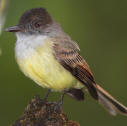 * Dusky-capped flycatcher, Myiarchus tuberculifer, another passerine tyrant flycatcher that breeds during winter at the Hacienda Chichen Bird Refuge and gardens. Both sexes have same plumage: gray breast, yellowish belly, blackish short crest head and brown upperparts with pale outer tail and wings feathers. It is a bit difficult for a birder to ID as it is also Similar to other Myiarchus species such as the Myiarchus crinitus, but the dusky-capped is a bit smaller in size and has a sorrowful whistled note. Loves gumbo-limbo berries but feeds mostly on insects that catches in fly. Builds its nest on tree cavities incubating normally three small brown marked buff eggs. (right photo) * Dusky-capped flycatcher, Myiarchus tuberculifer, another passerine tyrant flycatcher that breeds during winter at the Hacienda Chichen Bird Refuge and gardens. Both sexes have same plumage: gray breast, yellowish belly, blackish short crest head and brown upperparts with pale outer tail and wings feathers. It is a bit difficult for a birder to ID as it is also Similar to other Myiarchus species such as the Myiarchus crinitus, but the dusky-capped is a bit smaller in size and has a sorrowful whistled note. Loves gumbo-limbo berries but feeds mostly on insects that catches in fly. Builds its nest on tree cavities incubating normally three small brown marked buff eggs. (right photo)
* Eastern Wood-Pewee, Contopus virens, another common migrating flycatcher found at Hacienda Chichen grounds, adults have gray olive upperparts with two wing bars and light underparts, also a light olive wash on their breasts. This small songbird has a whistled singing note that gave rise to its name. Easter Wood-Pewee has a clear loud chip call with alternative notes when singing; they build open cup nests made of grass and bark both sexes are territorial and defend their nest aggressively, they feed mainly on insects. (photo click here)
* Great crested flycatcher, Myiarchus crinitus, loves to hunt insects from deciduous forest treetops; thus, easier to be hear than seen. The great crested flycatcher is a mid-size songbird with bright yellow belly and cinnamon Rufus wings and tail that has pale wing-bars. Breeds in open deciduous semi-open areas and nests in cavities lining them with snakeskin and soft bark and small twigs. (photo found in our above flycatchers collection*)
* Great Kiskadee, Pitangus sulphuratus, called X'takay in Maya as do all similar color plumage birds do. This is a large tyrant songbird, measures aprox. 11 inches) that enjoys perching on tall trees in open areas. It is considered monotypic. It has a black short and thick bill bright yellow under-part, black head with a strong white eye-stripped. It has a strong noisy call. Almost omnivorous, a great hunter. Both sexes build the ball like nest with a side entrance. Three cream eggs with reddish brown blotches are incubated. Territorial and a bit aggressive with other species. 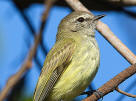 (photo in our flycatcher set above*) (photo in our flycatcher set above*)
Greenish Elaenia, Myiopagis viridicata, a perching resident flycatcher from the Tyrannidae family. A small bird with grey head and short beak with some yellow on wing bend and no wing bars; its grey throat merges into a olive dusky chest and pale breast and belly. Best ID for its buuur-zeeep call note, it is truly a shy bird and usually is found in the garden bushes where some clearing areas are quiet at Hacienda Chichen gardens, perching solitary up high.
Least flycatcher, Empidonax minimus, migratory songbird visitor in Spring that has white underbelly and olive-gray coloring on the back. Two white bars on their wings help identify it from other flycatchers. Feeds hawking from the air on insects.
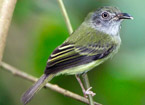 Northern Bentbill, Oncostoma cinereigulare, native to Mesoamerica, this small resident flycatcher can be observed in numerous areas of Hacienda Chichen. A member of the Tyrannidae family, it perches in small bushy shrubs around the gardens. Has an olive-grayish upper-part and pale lime yellow chest and belly with thin orange with small dark mark curved beak. Feeds mostly on small berries, spiders and flies. Solitary by nature even during breeding season Mar,ch / April. Nests are globular structure pendants built with vegetable fibers between 30 to 60 cm above ground; female lays one or two eggs. Northern Bentbill, Oncostoma cinereigulare, native to Mesoamerica, this small resident flycatcher can be observed in numerous areas of Hacienda Chichen. A member of the Tyrannidae family, it perches in small bushy shrubs around the gardens. Has an olive-grayish upper-part and pale lime yellow chest and belly with thin orange with small dark mark curved beak. Feeds mostly on small berries, spiders and flies. Solitary by nature even during breeding season Mar,ch / April. Nests are globular structure pendants built with vegetable fibers between 30 to 60 cm above ground; female lays one or two eggs.
* Social flycatcher, Myiazetetes similis - (X'takay in Maya) is a member of the tyrant flycatcher bird family. Social flycatchers plumage resemble that of Boat-billed flycatchers and Great Kiskadee birds; however social flycatcher adult birds are smaller,18 cm. long. The male head has a dark almost black crown with a strong white eye stripe; the upperparts are olive brown, wings and tail have gray brown feather tones. Social flycatcher belly and under-parts are bright yellow and the throat is white. At the Hacienda Chichen these cheerful birds' calls chips-k'-cheery are sang all day long to the enjoyment of guests and visiting birders. Social flycatcher birds love to perch in the open terraces of the hotel and feed on small berries from many of the trees around the hotel's main arch. They nest near water from February to June. (photo found in our above flycatchers collection*)
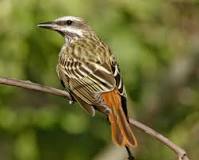 Sulphur-bellied flycatcher, Mylodynastes luteiventris - A resident of Hacienda Chichen's main garden, this lovely tyrant flycatcher belongs to the Passeriformes order. It has distinctive strong streaking in its plumage, a black eyes-tripe, pale yellow-lime colored belly, and a deep rusty brown tail. Its call has a deep squeaky sound as it perches on high tree branches in semi-open garden areas. These flycatchers' nest are shaped like a cup, and can be found in old woodpecker holes or tree cavities with two to four small eggs. Suphur-bellied flycatchers hawk their prey, normally feeding on insects, but also enjoys seeds and berries. Sulphur-bellied flycatcher, Mylodynastes luteiventris - A resident of Hacienda Chichen's main garden, this lovely tyrant flycatcher belongs to the Passeriformes order. It has distinctive strong streaking in its plumage, a black eyes-tripe, pale yellow-lime colored belly, and a deep rusty brown tail. Its call has a deep squeaky sound as it perches on high tree branches in semi-open garden areas. These flycatchers' nest are shaped like a cup, and can be found in old woodpecker holes or tree cavities with two to four small eggs. Suphur-bellied flycatchers hawk their prey, normally feeding on insects, but also enjoys seeds and berries.

* Tropical Pewee, Contopus cinereus, another small tyrant flycatcher found at the edges of the gardens perching in Hacienda Chichen tall ficus. Large in numbers, they reside in the grounds all year round, nesting in small open saucers made our of soft grass and linchen chunks, built in branch forks by the female who lays two creamy off white eggs marked with red-brown spots, both parents defend their nest aggressively specially from the Great kiskadeee. Dark brownish grey under-parts and dark grey crown plumage, a pale olive yellow belly as well as two white wing bars with some variations on plumage are common in this species. Its call has a sharp weeet call. (right photo* )
Tropical Kingbird, Tyrannus melancholius (X'takay in Maya), this large tyrant Flycatcher is one of the many resident songbirds at Hacienda Chichen gardens and grounds. Both sexes are similar with pale-gray head plumage and a darker eye mask, they showcase an orange crown stripe and a heavy grey bill. The back is greyish-green, and the wing and forked tail are brown. The throat is pale grey, becoming olive on the breast, with the rest of the underparts being yellow. Their call has a high-pitched twittering trill note. They defend their territory with an aggressive behavior toward other birds, They nest in ficus in upper tree canopies.
Yellow-bellied elaenia, Elaenia flavogaster, another songbird from the tyrant flycatcher family common to the Yucatan peninsula. It is a conspicuous little bird that has yellow-olive under-parts, white eye-ring and bushy crest. it has a nasal call and can be found around the gardens eating insects and small berries. Builds cup nests.
Yellow-bellied flycatcher, Empidonax flaviventris, a noisy little flycatcher with a large semi-crested head, yellowish eye-ring, yellowish cream throat and breast, two broad yellow or white wing-bars. Yellow-bellied flycatchers are found in semi-open habitats.
Yellow-olive flycatcher, Tolmonyias sulphurescens, a small songbird found at Hacienda Chichen Resort's grounds. Feeds on insects, small seeds and berries. Its call is a nasal breeer, and the song has a wheezing zhu-zhee-zhu-zhee note. It makes a cup nest and lays two cream eggs with reddish blotches at the larger end.
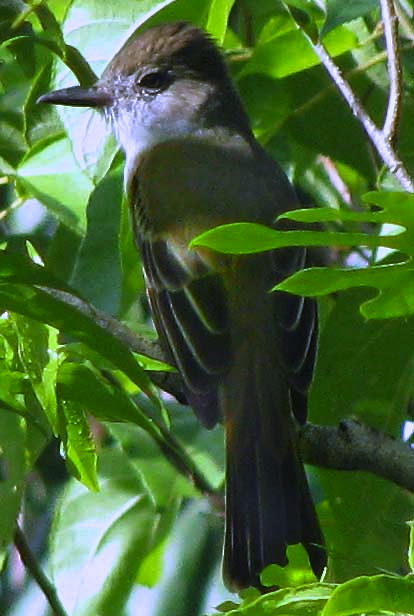 * Yucatan flycatcher, Myiarchus yucatanensis – a small tyrant flycatcher and an endemic bird species of the Yucatan Peninsula, called X'takay in Maya, as ancient Maya grouped birds for their plumage alike color design and habits. This small flycatcher bird resides all year round at Hacienda Chichen Resorts garden edges near the rejoyadas on mid-range cannopy. There are three subspecies currently recognized: Myiarchus yucatanensis, Myiarchus lanyoni, and Myiarchus navai, all within the Maya world (Yucatan Peninsula, Chiapas, Guatemala and Belize) it is easy to ID mainly due to its vocal characters. (right photo*) * Yucatan flycatcher, Myiarchus yucatanensis – a small tyrant flycatcher and an endemic bird species of the Yucatan Peninsula, called X'takay in Maya, as ancient Maya grouped birds for their plumage alike color design and habits. This small flycatcher bird resides all year round at Hacienda Chichen Resorts garden edges near the rejoyadas on mid-range cannopy. There are three subspecies currently recognized: Myiarchus yucatanensis, Myiarchus lanyoni, and Myiarchus navai, all within the Maya world (Yucatan Peninsula, Chiapas, Guatemala and Belize) it is easy to ID mainly due to its vocal characters. (right photo*)
BACK TO BIRD GUIDE LIST
Galliforms:
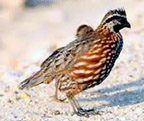 Yucatan bobwhite or Black-throated bobwhite, Colinus nigrogularis, "Bech" in Maya. Like its northern relative, though smaller, this endemic quail emits a sound like a masked bobwhite. It belongs to the Odontophoridae family. The male's face is black with white stripes above and below their eyes. This bird has a black throat and a reddish brown crown; the chest and belly plumage is white with black in a very noticeable pattern of flakes. The back, wings and tail are reddish brown. Females are similar to the northern masked bobwhite quail with chestnut throat. Yucatan bobwhite or Black-throated bobwhite, Colinus nigrogularis, "Bech" in Maya. Like its northern relative, though smaller, this endemic quail emits a sound like a masked bobwhite. It belongs to the Odontophoridae family. The male's face is black with white stripes above and below their eyes. This bird has a black throat and a reddish brown crown; the chest and belly plumage is white with black in a very noticeable pattern of flakes. The back, wings and tail are reddish brown. Females are similar to the northern masked bobwhite quail with chestnut throat.
BACK TO BIRD GUIDE LIST
Grackles and Cowbirds:
Almost all black feathered birds are called Pi’ich (such as the black melodious bird) or X'Kau (grackles and cacique) in Maya, even though they are not of the same bird family or bird species: see photos bellow, Black Melodious is a songbird that delights anyone with its lovely melodious singing notes at Hacienda Chichen Bird Refuge and Gardens.
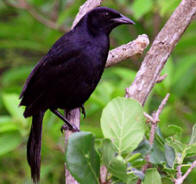 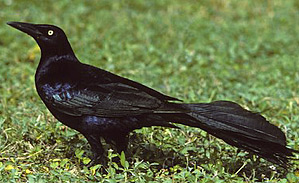 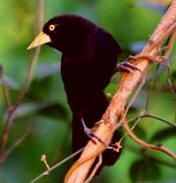
Melodious Blackbird Great-tailed Grackle Yellow-billed cacique
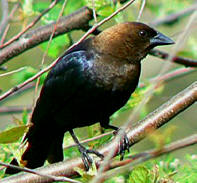 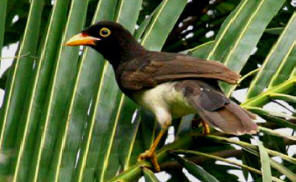 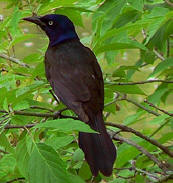
Bronzed cowbird Brown Jay Common grackle
* Melodious blackbird, Dives dives, endemic to the New World Icterid bird list, and there is no subspecies. This midsized black songbird resides in tropical regions, from the East Mexican coastline, to the Yucatan peninsula and down to Costa Rica. This delightful melodious songbird is a permanent resident at Hacienda Chichen, you can hear its joyful songs around the hotel's gardens all day long. This blackbird enjoys visiting guests at meal time at the terrace restaurant for a few treats, fruit, seeds, and even a bit of warm bread. Males and females have identical black bluish glossy plumage, their eyes, feet and bill are deep black. These birds seen in a duet pair with many joyful notes, whistles, and calls. Prefers open spaces and forages insects,, mainly on the ground; loves to feed on nectar and sweet fruits. Highly territorial, especially during breeding season. Both sexes build a cup nest high in tree branches. The female lays three or four brown-blotched blue eggs, which she incubates alone, although the male helps with feeding the chicks. ( first top photo found left side in our above photo set*)
* Common grackle, Quiscalus quiscula, (Pi’ich in Maya) is a permanent resident and very common in Yucatan. A large black bird from the Icteridae family, the male is just a bit larger than the female. As adults both have long dark tail, long dark bill and pale yellowish eyes Their feathers appear black with iridescent purple, green or blue shades on their head. Nest are concealed in lush tall tree branches. ( last bottom right photo found in our above set*)
* Yellow-billed cacique, Amblycercus holosericeus (called also Pi’ich in Maya) Another resident bird to the Hacienda Chichen gardens. It is a large black bird with deep yellow peak and bright yellow eyes from the Icteridae family. Not a true cacique but related to the species, this impressive monotypic bird belongs to the genus Amblycercus. Has a long black shinny tail; it feeds by pecking leaves and twits for insects. The nest has a classic cup-shaped made of twits and fibers. The Yellow-billed cacique found in Yucatan is a lowland bird with no relationship to the bamboo specialized group found in Costa Rica. - (left top photo found in above photo set*)
* Great tail grackle, Quiscalus mexicanus (X'Kau in Maya) is a common resident to our gardens native to North and Central America. It has a medium size with deep black and violet-blue iridescent plumage and a long slender tail. Another member of the Icteridae family, this bird can rich up to 17 inches in length. The great tail grackle has a vast range of call notes, some quite melodic. You can spot them easily at sundown and down often congregated in large flocks. Cunning and opportunists by nature, these birds are brave and approach humans for food and scraps as they are omnivorous. - (center top photo found in our above bird photo collection*)
* Bronzed cowbird or Red-eyed cowbird, Molothrus aeneus this Icteridae bird is smaller than those in above, it is also a common resident to the Yucatan; the male has a green-rusty-brown neck and head coloration with shinny black body plumage. The female is smaller and has a duller look, she lays its eggs in other bird species nests such as the prevost's ground sparrow and the yellow-throated brush finch; her young are fed by such bird parents. - (bottom left photo found in our above bird photo collection*)
* Brown Jay, Psilorhinus morio, please click here for brief info- It is displayed in the above, bottom center, photo set since the Maya people commonly group birds by color not species; thus, it is in the Maya family of the deep dark birds or Box Kau (black / brown plumage).
BACK TO BIRD GUIDE LIST
Gnatcatchers and Grassquits:
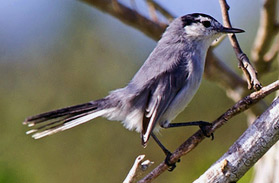 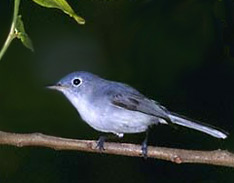 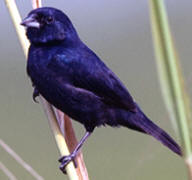
White-lored gnatcatcher Blue-gray gnatcatcher - female Blue-black grassquit
Blue-gray gnatcatcher, Polioptila caerulea, looking like a miniature mockingbird, this little bird has a lovely blue-gray feathers atop and white belly with a distinctive white eye ring, broad white borders on black tail. Male have a deep blue gray eyebrow band, females do note (above photos). Parents are quite vocal and build exquisite nests, lovely singing birds.
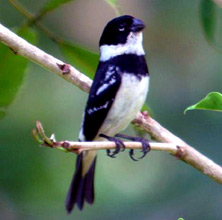 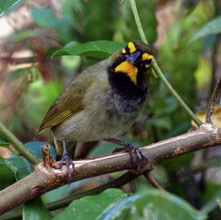 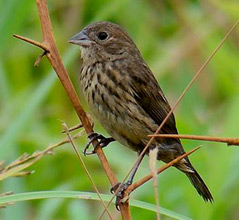
White-collared seedeater Yellow-faced grassquit Blue-black grassquit - female
Blue-black grassquit, Volatinia jacarina, resident of Hacienda Chichen Bird Refuge, this lovely songbird has deep blue black plumage all over its body. These grassquit birds form flocks and enjoy feeding in open weed fields and habitats.
* White-collared seedeater, Sporophila torqueola, a passerine bird that has a softh delightful call and whistled singing feeds in the low weedy places of Hacienda Chichen gardens, thus, the hotel leaves tall weedy areas around the garden near the Church. they nest in small colonies and sing to defend their territory. Both parents feed seeds and small insects to their young.
White-lored gnatcatcher, Polioptila albiloris, males have glossy black caps extended to their eyes as it curves around the white cheek. It is found at Hacienda Chichen's semi-arid scrubby garden areas. Its call has a nasal scratchy sound and pairs breed during spring and early summer. They eat insects: caterpillars and small beetles.
Yellow-faced grassquit, Tiaris olivacea, is a small passerine seedeater and a melodious bird with a sharp conical bill; males have a bright yellow throat with deep olive green backs, gray legs, black plumage on breast and face. Females have dull olive green plumage and pale grayish underparts. Their call has a low soft buzzing sound with high rapid trills.
BACK TO BIRD GUIDE LIST
Hawks and Goatsucker Birds:
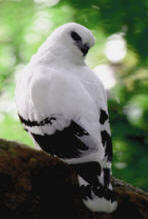 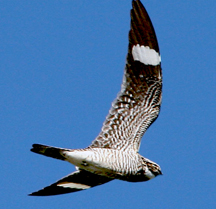 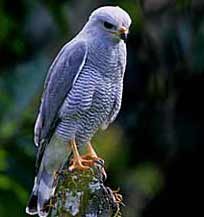 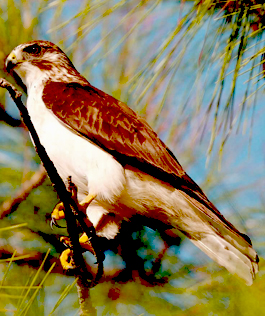
White Hawk Common Nighthawk at dusk Gray Hawk male Short-tailed Hawk
Common Nighthawk, Chordeiles minor, with an appearance similar to owls, this nocturnal insectivore hawk, is a migrating hawk difficult to spot during the daytime. Best seen at dusk and twilight hours. Has a distinctive plumage dark brown and gray coloration and patterns, slender dark wings with large white patch. Distinguished by its forked tail, this hawk prefers to perch when resting or take flight; it is easy to locate at dusk due to its clear vocalization. It enjoys roosting together, but it is primarily a solitary territorial hawk. It can measure up to 10 inches and has a five year lifespan. Feeds on insects mainly. Do not disturb, they are know to attack intruders.
Chuck-will’s-widow, Caprimulgus carolinensis, the largest nightjar in America, ranging up to 23 inches in length. A migrating nightjar famous for its repetitive vibrating night calls, thus its name. With a short bill and long tail, this bird has reddish brown feathers lined with black and white patterns (see photo), males have white patches on their outer tail. Its nocturnal insects, small birds and bats. Females lay spotted pinkish - lavander eggs on dead leaves on the ground.
Gray Hawk, Buteo nitidus, a neo-tropical raptor or bird of prey that breeds at Hacienda Chichen's lush gardens and wild forest edges. This beautiful raptor is know to Mayans as Yoksadz. Adult Gray hawks reach up to 50cm in height and hunt for food primarily using their talons; these raptors eat lizards, snakes, birds, small animals. Gray hawks display a characteristic curved tip to their beak. They have superb vision and hunting skills. Grey hawks also they have strong pale grey bodies, black tail with three wide white bands. Wings are gray, their striking stripped gray and white feather pattern covers breast; Gray hawks have strong orange legs. Gray hawks are short winged and have a fast agile flight. Territorial in nature; they highly guard their breeding grounds; their nests usual are high and have two pale blue white eggs.
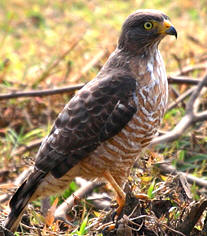 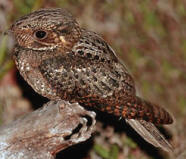 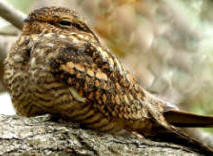 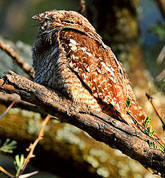
Roadside Hawk Chuck-will’s-widow Lesser Nighthawk Yucatan nightjar
Lesser Nighthawk, Chordeiles acutipennis, is very similar to the common nighthawk but a bit smaller. Both have redish-brown-gray patterning on the upperparts and chest, but the Lesser nighthawk has a puffier breast and under plumage with a softer coloration. What helps distinguish them in the field, is that their calls are completely different sounds, the Lesser nighthawk call has a rapid melodious rhythm that lasts for couple of minutes. They also nest on the ground or on flat roof structures; eggs are off white with multiple tiny brown spots, look dirty. Aggressive and territorial when nesting and breeding. they eat at night many insects while in flight. You can spot them sometimes near our garden tall lights due to the insects attracted to them.
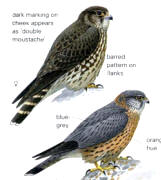 Pigeon Hawk or Merlin, Falco Columbarius, a migratory bird of prey that has taken residence at Hacienda Chichen's private Nature Reserve. Easy to distinguish among other falcons. The drawing placed in this page, will help you recognize both female and male adults. Argument still flows if genetically the Eurasian an North America populations are distinct species. It has a wingspan of about 29 inches and a robust built; males have blue gray back and buff under-parts with orange tinted marks. Females have a brownish gray back and spotted under-part marks. They are easier to find at the Hacienda Chichen's private Nature Reserved grounds during the winter months. Pigeon or Merlin Hawks are great hunters, fly fast and low searching for pray but can catch other birds in mid-air. It is very important to protect their habitat and breeding area as over disforestation is widespread. Pigeon Hawk or Merlin, Falco Columbarius, a migratory bird of prey that has taken residence at Hacienda Chichen's private Nature Reserve. Easy to distinguish among other falcons. The drawing placed in this page, will help you recognize both female and male adults. Argument still flows if genetically the Eurasian an North America populations are distinct species. It has a wingspan of about 29 inches and a robust built; males have blue gray back and buff under-parts with orange tinted marks. Females have a brownish gray back and spotted under-part marks. They are easier to find at the Hacienda Chichen's private Nature Reserved grounds during the winter months. Pigeon or Merlin Hawks are great hunters, fly fast and low searching for pray but can catch other birds in mid-air. It is very important to protect their habitat and breeding area as over disforestation is widespread.
Roadside Hawk, Buteo Magnirostris, is a laud small bird of prey with many subspecies; thus, its plumage can vary from brown to grey hues and tones with stripped like patterns in its underparts. It has a large deep yellow peak with dark ending mark. In flight you can observe its short wings compared to its longer tail. This hawk is well adapted to our ecosystem and has aggressive temper, specially at the time of breeding and nesting. Feeds on insects and small mammals.
Short-tailed Hawk, Buteo albonotatus
White Hawk, Leucoptemis albicollis, (see photo under title Hawks) a laud
Yucatan nightjar, Caprimulgus badius, called "Box Pujuy" in Maya, is very similar to the Yucatan poorwill and non-professional birders may confuse both in field. Though their plumage is extremely similar in wavy spotted pattern and color that blend perfectly with its semi-arid scrubby habitat, Yucatan nightjar has more white at the tip of his tail and wider white fore-collar. Their nocturnal call notes are very rhythmic clear and very loud. They enjoy same habitat ambience as the Yucatan poorwill, and they also lays their eggs on the ground around April / Aug. Both parents attend the incubation of no more than two elliptical white eggs with sparsely flecked with brown shades. This is a very sedentary bird that feeds mainly on insects and is highly territorial. (photo above right)
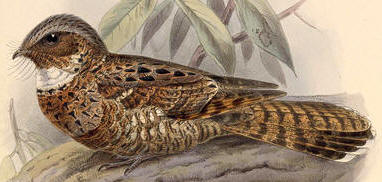 Yucatan poorwill, Nyctiphrynus yucatanius, called "Chac Pujuy" in Maya, this endemic mid-size nightjar belongs to the Caprimulgidae family. It is protected at Hacienda Chichen's private Nature Reserve. Nocturnal and very territorial; enjoys quiet semi-arid deciduous forest areas, feed on insects from ground and perches on tree. Male emits repetitive loud rhythmic calls at dusk. Males and females have similar plumage that blends perfectly with bark and dry leafs making it difficult to spot. Upperparts brown streaked brown-blackish, distinct spot on wing-coverts, a narrow white collar, and truly small peak. Lay eggs on the ground, both parents caretakers. Yucatan poorwill, Nyctiphrynus yucatanius, called "Chac Pujuy" in Maya, this endemic mid-size nightjar belongs to the Caprimulgidae family. It is protected at Hacienda Chichen's private Nature Reserve. Nocturnal and very territorial; enjoys quiet semi-arid deciduous forest areas, feed on insects from ground and perches on tree. Male emits repetitive loud rhythmic calls at dusk. Males and females have similar plumage that blends perfectly with bark and dry leafs making it difficult to spot. Upperparts brown streaked brown-blackish, distinct spot on wing-coverts, a narrow white collar, and truly small peak. Lay eggs on the ground, both parents caretakers.
Zone-tailed Hawk, Buteo albonotatus
BACK TO BIRD GUIDE LIST
Hummingbirds:
All hummingbirds are called Dzunum or Tz'unu'un in Yucatec Maya language. Hummingbirds are a joy to observe and very difficult to photograph due to their speed and tinny bodies. Bellow are the various colorful hummingbirds you will find at Hacienda Chichen Resort gardens and private Maya Nature Reserve. Easy to spot drinking our flower's nectar early morning, specially from the Heliconia family near the terrace restaurant and Yaxkin Spa.
Hummingbirds belong to the order Apodiformes; there are three families: Trochilidae (hummingbirds), Hemiprocnidae (tree swifts), and Apodidae (swifts). Trochiline male hummingbirds often have bright, colorful iridescent feathers while their female counterparts have lighter coloration. Both sexes have elongated narrow beaks, extendable tongues and a vivid hovering flight. Trochilines are territorial solitary birds, they feed mainly on nectar and a few insects. Hummingbirds are polygynous, only females build nests and care for their young. Learn more about hummingbirds, by ADW, University of Michigan.
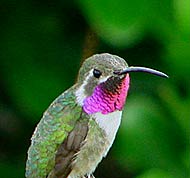 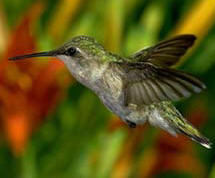 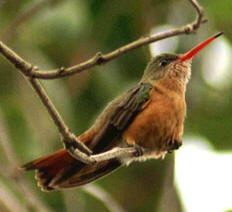 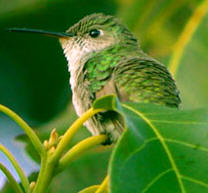
Mexican sheartail Emerald-chinned hummingbird Cinnamon hummingbird White-bellied Emerald
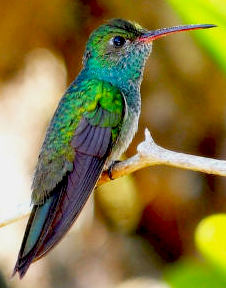 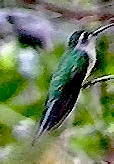 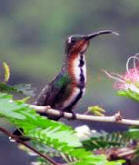 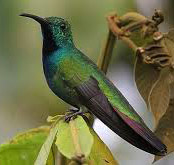 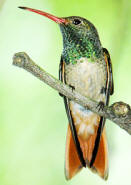
Canivet’s Emerald / Wedge-tailed sabrewing / Green breasted mango female and male / Buff-bellied
* Buff-bellied Hummingbird, Amazilla yucatanensis - called Dzunum or Tz'unu'un in Maya - (right bottom photo)
* Canivet’s Emerald hummingbird, Chlorostibon canivetii, weights less than an once and grows up to 3 inches. At Hacienda Chichen Bird Refuge, you can observe the subspecies C.c. salvini which is protected as it is listed as an endangered bird. The male has metallic emerald feathers with a forked dark blue tail, almost black. Females have less bright green plumage with a dark eye mask and a white top line. Easy to spot in our gardens near the lovely heliconias, specially early morning hours. - (left bottom photo)
* Cinnamon hummingbird, Amazilla rutila, called Tz'unu'un in Maya -(right center top photo)
* Emerald-chinned hummingbird, Abeillia abeillei - (left center top photo)
* Green breasted mango, Anthracothorax prevostii (Dzunum in Maya) - (female and male center bottom photos)
* Mexican sheartail, Doricha eliza, "Dzunum" in Maya is a species belonging to the Trochilidae family that is only found in Mexico's subtropical shrub-land rural gardens, seldom in few urban garden areas. This tiny hummingbird is endangered due to habitat lost; thus, protected at Hacienda Chichen Bird Refuge and Maya Jungle Reserved, where their population has grown and taken residence. Little is known about the Mexican Sheartail hummingbird behavior; it feeds on the nectar of flowers and can be observed near the hibiscus hedges in the garden's paths. The Mexican Sheartail hummingbird has a bright metallic green plumage upperparts and a magenta throat. (left top photo)
Ruby-throated hummingbird, Archilochus colubris, (Dzunum in Maya most hummingbirds)
* White-bellied Emerald hummingbird, Amazilia candida
* Wedge-tailed sabrewing, Campylopterus pampa, is a large hummingbird with a long wedge-shaped tail. Upperparts are green with blue to violet-blue crown that blends into the green nape. It has a white spot behind its eyes and a dark gray cheek. Breeds from March to July and enjoys the nectar of our heliconias and flowers.
BACK TO BIRD GUIDE LIST
Jay Birds:
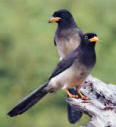 Brown Jay, Psilorhinus morio, Corvidae family, endemic to the East costal region of Mexico and the Yucatan and Central America, this corvid bird is among the most intelligent birds known to science. Brown Jays vary in plumage geographically, the Yucatan brown jays have deep brown wings upper-parts and wings witn cream tips on tail plumage; their under parts and belly is light cream. Bill and legs are deep yellow with orange tones; eyes have a deep yellow ring. Their calls have a loud but low pitched pee-ah tone. Very social and brave, nest has three to six eggs, both parents build it and feed chicks. Feeds on insects, small seeds and young fruits from various trees. Brown Jay, Psilorhinus morio, Corvidae family, endemic to the East costal region of Mexico and the Yucatan and Central America, this corvid bird is among the most intelligent birds known to science. Brown Jays vary in plumage geographically, the Yucatan brown jays have deep brown wings upper-parts and wings witn cream tips on tail plumage; their under parts and belly is light cream. Bill and legs are deep yellow with orange tones; eyes have a deep yellow ring. Their calls have a loud but low pitched pee-ah tone. Very social and brave, nest has three to six eggs, both parents build it and feed chicks. Feeds on insects, small seeds and young fruits from various trees.
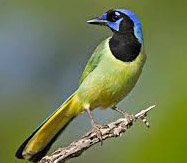 Green Jay, Cyanocorax luxosus, this beautiful jay is known to Yucatan's Maya as majestic "Ses Ib". Green jay body plumage stands out with beautiful shades of deep lime and green on back and wings; deep yellow under tail feathers. Its iridescent blue-violet head top contrasts beautifully with its black marking bib coming from the head sides and throat. The green tail has yellow feathers on each side that are seen as it flies. Green Jays inhabit well preserved low or medium forest, feeding on fruits, tender shoots and flowers. Breeds and nests in deep foliage areas. Enjoys flying solitary but known to fly in groups of two or more during mating season. Yucatan's side roads and open forest areas are perfect places to find the green jay. Green Jay, Cyanocorax luxosus, this beautiful jay is known to Yucatan's Maya as majestic "Ses Ib". Green jay body plumage stands out with beautiful shades of deep lime and green on back and wings; deep yellow under tail feathers. Its iridescent blue-violet head top contrasts beautifully with its black marking bib coming from the head sides and throat. The green tail has yellow feathers on each side that are seen as it flies. Green Jays inhabit well preserved low or medium forest, feeding on fruits, tender shoots and flowers. Breeds and nests in deep foliage areas. Enjoys flying solitary but known to fly in groups of two or more during mating season. Yucatan's side roads and open forest areas are perfect places to find the green jay.
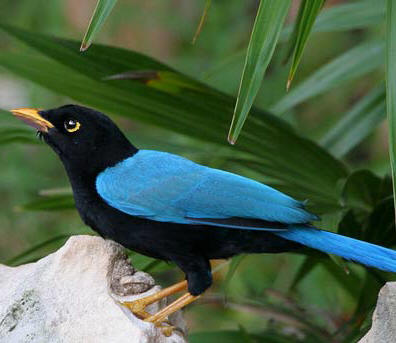 Yucatan Jay, Cyanocorax yucatanicus, called Ch'el in Maya, is an endemic bird species to the Yucatan Peninsula. Protected at Hacienda Chichen Bird Refuge, where birders have the unique opportunity to see it enjoy many of the fruits of the hotel's organic plantain orchard. This is a jay with a brilliant turquoise blue plumage on back and wings, bright yellow peak, feet, and eyeliner, with black feather head, throat, and belly. Breeds in undisturbed wooded areas, nesting in small flocks. Can be seen eating near banana and fruit crops, or insects and seeds. Flies in small groups and enjoys pastures and open fields; very talkative and social. The Yucatan Jay is a medium size bird that can be observed all times of the day. Adult birds have black peaks and feet. Yucatan Jay, Cyanocorax yucatanicus, called Ch'el in Maya, is an endemic bird species to the Yucatan Peninsula. Protected at Hacienda Chichen Bird Refuge, where birders have the unique opportunity to see it enjoy many of the fruits of the hotel's organic plantain orchard. This is a jay with a brilliant turquoise blue plumage on back and wings, bright yellow peak, feet, and eyeliner, with black feather head, throat, and belly. Breeds in undisturbed wooded areas, nesting in small flocks. Can be seen eating near banana and fruit crops, or insects and seeds. Flies in small groups and enjoys pastures and open fields; very talkative and social. The Yucatan Jay is a medium size bird that can be observed all times of the day. Adult birds have black peaks and feet.
BACK TO BIRD GUIDE LIST
Mockingbirds:
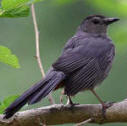
Gray Catbird, Dumetella Carolinensis, called Box Chika' in Maya, is a mid-sized perching bird; the only member of the "catbird" genus Dumetella of the Mimidae family. This bird species is named for its cat-like call but it also mimics other birds songs. Male and female birds look alike with plain grey plumage and the head top darker, almost black, the undertail coverts are rust colored. Gray Catbirds enjoy perching inside bushes and small trees when choosing to sing their many musical tones when hidden in undergrowth. These birds breed in semi-open dense areas, they build bulky cup nests and lay pale turquoise eggs (two or three). Both parents take turns feeding the young birds.
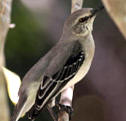
Tropical Mockingbird, Mimus gilvus, a resident passerine bird from the Mimidae family. Both female and male are alikewith grey plumage on the head and upper parts and a white-eye-stripe and dark patch through its yellow eye. The Tropical Mockingbird long tail is dark with white feather tips. These resident birds have a varied of musical songs; enjoy eating insects and small wild berries. They build twig nests that are aggressively protected by the female.
BACK TO BIRD GUIDE LIST
Motmots:
The Motmots are a bird species called Toh in the Maya language, and can be observed regularly at the Hacienda Chichen Bird Refuge and Maya Jungle Reserve. These near-passerine birds of the Momotidae family are in the order of Coraciiformes. You can find these motmots in woodlands and neotropical forests. Both species have beautiful and colorful plumage (see photos below), long racket like tip tails, and heavy bill; they love to move their tail in a waging back and forth motion when they detect predators. Toh birds, as the Maya call them, eat small pray such as insects, lizards, and fruit. These species enjoy forming large bird colonies and nest in bank tunnels and limestone caves laying about four eggs; with both parents caring for the young.
Turquoise-browed motmot, Eumomota superciliosa, (bottom left photo) has distinctive multi-color plumage and light turquoise crown, black eye marks, and two long tail semi-naked feathers with a drop like decorative shape tip.
Blue-crowned motmot, Motmotus momota (bottom right photo) also named "Toh" by the Mayas, has similar facial marks and multi green/blue feathers with yellow/orange bellies, though its two semi-naked tail feathers are a bit shorter. Toh birds are among the few cave dwellers species, nesting in wells and Yucatan's cenotes.
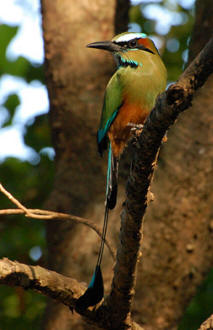 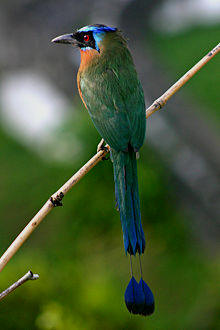
Turquoise-browed motmot, Eumomota superciliosa Blue crowned motmot, Momotus momota
BACK TO BIRD GUIDE LIST
Oriole Birds:
Oriole birds are passerine birds in the New World family of Icteridae. These perching birds are known as songbirds for the joyful melodic singing of their rich whistles. Most orioles at Hacienda Chichen feed on insects, nectar and the Gumbo-limbo fruits, Bursera simaruba. They have bright yellow and deep orange color plumage with black and white marks near neck, tail, and in their wing feathers. Fairly common to find each morning are the following beautiful oriole species, do observe the different subdue markings and plumage differences:
** The below Orange and Deep Yellow Oriole Birds are called Chel in Maya / Melodious Blackbird is called Pi'ch:
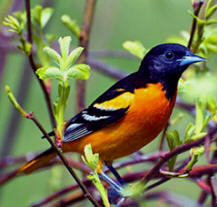 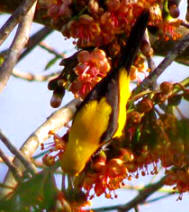 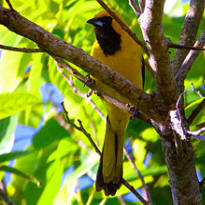
Baltimore oriole, Icterus galbula Yellow-backed, Icterus chrysater Yellow-tailed, Icterus mesomelas
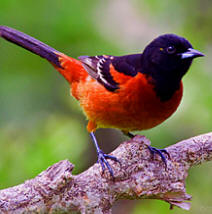 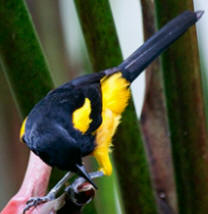 
Orchard oriole, Icterus spurius Black-Cowled oriole, I. Dominicensis Melodious black, Dives dives
** The below beautiful Oriole Birds are called Yuyum in Maya:
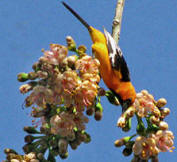 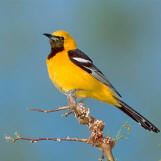 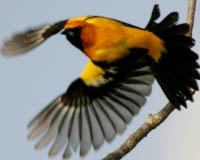
Altamira oriole, Icterus gularis Hooded oriole, Icterus Cucullatus Orange oriole, Icterus auratus
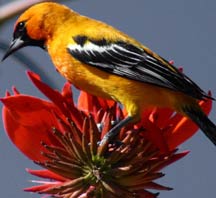 Orange Oriole, Icterus auratus, an endemic bird species found only in Yucatan Peninsula, mostly on tall tree branches. The male all body is covered with bright deep yellow with under hues of orange plumage; the wings are black with clearly marked white bands, the eye and neck have some areas of black plumage. It inhabits low forest and areas with fruit and flower trees, eats nectar, insects, seeds, and a few seeds. Nests with other birds of its kind, sociable and adapted, the Orange oriole, weaves impressive nests from plant fibers and tree or grass cuts; its nest are large, made out of straw and dry sticks artistically woven to hang. Orange Oriole, Icterus auratus, an endemic bird species found only in Yucatan Peninsula, mostly on tall tree branches. The male all body is covered with bright deep yellow with under hues of orange plumage; the wings are black with clearly marked white bands, the eye and neck have some areas of black plumage. It inhabits low forest and areas with fruit and flower trees, eats nectar, insects, seeds, and a few seeds. Nests with other birds of its kind, sociable and adapted, the Orange oriole, weaves impressive nests from plant fibers and tree or grass cuts; its nest are large, made out of straw and dry sticks artistically woven to hang.
BACK TO BIRD GUIDE LIST
Owl Birds:
 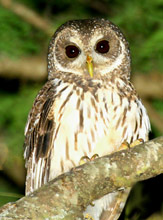  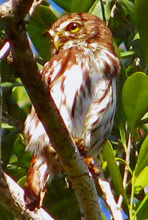
Barn owl Mottled owl Great horned owl F. Pygmy owl
Barn owl, Tyto alba, lechuza común (Spanish) called Xoch' in Maya. Primary a nocturnal sedentary owl with high auditory acuity, the only member of the family Tytonidae (all other owls are from the Strigidae family). Sometimes called the monkey-faced owl family, this medium sized owl is easy to ID as it lacks ear tufts and has a distinctive heart shaped facial disk unlike all other owls. Barn Owl enjoys warm weather and lowland habitats, its diet is mainly wild rodents and reptiles. It builds its nest sites in hollows or natural cavities in trees.
Ferruginous pygmy owl, Glaucidium brasilianum ridwayi, Buho Viejita o Mochuelo Caburé (Spanish) called X'nuk in Maya. It is a small sedentary owl with reddish-brown-rust color and white plumage. You can hear its calls fromyour own room patio terraces at Hacienda Chichen gardens and observe pygmy owls during the early dusk (crepuscular hours) it is a ferocious predator, feeds on small mammals, birds and reptiles, that nests in tree cavities from all woodpecker holes and on tree depressions. Both adults bring food to their young.
Great Horned owl, Bubo virginianus mayensis, called búho real (Spanish) and Moan Ikim in Maya meaning the "wise-great-owl." This great horned owl subspecies is only found on the Yucatan Peninsula. In general, the Great horned owl is a family with 4 races and a native owl of the Americas. The largest and most powerful of all owls found at Hacienda Chichen Bird Refuge and private Maya Jungle Wildlife Reserve. It has prominent horned ear tufts and a clear facial disk bordered with black lines and has intense yellow-lime eyes. An adaptable sedentary predator feeds on any small to medium creatures as it has a powerful feet and a strong grip; perches and scans for pray before the hunt. Adapts to most habitats; nests in caves and hollows quarries or even in cactus' holes left by other birds. Both parents care for the young.
Mottled owl, Ciccaba virgata, a strictly nocturnal owl found in the Yucatan to South America, its habitat is very extensive and enjoys dwelling in forest areas and jungles such as that found in Hacienda Chichen Maya Jungle Reserve. Hunting from a perch, its diet consists on large insects, small mammals and reptiles. Nests can be found in old palm holes during January and February each year.
BACK TO BIRD GUIDE LIST
Quails:
Black-throated bobwhite, Colinus nigrogularis, "Bech" in Maya.
Yucatan Quail, Colinus virginianus
BACK TO BIRD GUIDE LIST
Parrots:
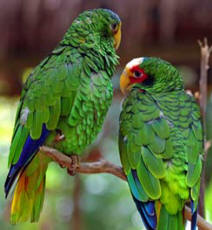 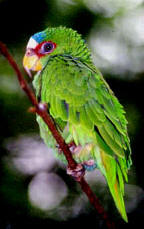
Yucatan Amazon Parrot White-fronted parrot
Amazona xantholora, T’uut in Maya Amazona Albifrons
White-fronted parrot, Amazona Albifrons, is found from Southern Mexico to Central America. An easy to detect parrot for its clearly marked bright red patch around the eyes and white forehead plumage; its body is covered with bright green feathers and has a red shoulder wing-spot. Strong yellow peak with dark tip. Flies in family groups in forests eating nuts, berries, seeds and ripe fruits. Nests in tree hollows.
Olive-throated parakeet, Aratinga nana, of the Psittacidae family. Called Periquito Verde (Spanish) or K'ijil (Maya) is found in Jamaica, Mexico and Central America in a wide range of fragmented habitats and areas. A very green looking parakeet with the head, back and tail bright green and their throat olive green, the eyes are orange with a dark iris, skin around the eyes is cream color.
Yucatan Amazon Parrots or Yellow Lored Amazon, Amazona xantholora, "T'uut" in Maya, are one of the many Yucatan endemic bird species found at Hacienda Chichen Maya Jungle Reserve, Chichen Itza, Yucatan. These lovely parrots of Yellow lories are only found in the Yucatan Peninsula, and a great family flock can be observed and heard every day at sunrise and later in the day. These birds travel in flocks from feeding grounds to their roosting sites. Parrots are monogamous for life and become good pets; but are best enjoy flying free in their medium forest habitat. Yucatan parrots love to fly together in small groups to feed on fruits, seeds, flowers high on tree branches. Talkative and noisy, their plumage is mainly emerald green with indigo blue outline wing feathers; when in flight, their red patched wings can be observed clearly. At the forehead, these birds have a patch of yellow feathers near the peak, a white spot covers the head top, red feather near eyes.
BACK TO BIRD GUIDE LIST
Plovers:
Killdeer, Charadrius vociferus, rare to observe at Hacienda Chichen Bird Refuge, but does venture to inland disturbed habitats and open fields.
Sparrows:
Olive sparrow, Arremmonops rufivirgatus, also known as Green Finch, family Emberizidae, essentially a Mexican bird species ranging up to Texas. It is a bush loving species, Its plumage has olive colors in general with a set of dark lines in its headline. A small seedeater bird that enjoys staying close to the grown.
BACK TO BIRD GUIDE LIST
Swifts:
Rufous-breasted Spinetail Synallaxis erythrothorax
Vaux’s Swift, Chaetura vauxi
BACK TO BIRD GUIDE LIST
Tanagers:
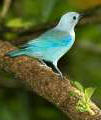 Blue-gray tanager, Thraupis episcopus Blue-gray tanager, Thraupis episcopus
Gray-headed tanager, Eucometis penicillata
Red-throated ant-tanager, Habia fuscicauda
Red-legged honeycreeper, Cyanerpes cyaneus
Rose-throated tanager, Piranga roseogularis – rare to observe
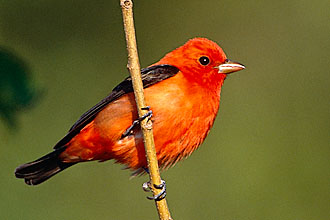 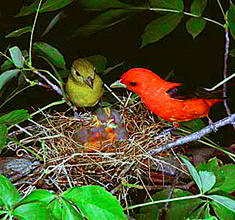 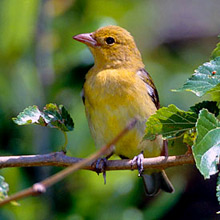
Scarlet tanager: male (left photo), feeding their young (center photo) female (right photo)
Scarlet tanager birds, Piranga Olivacea, formally classified in the tanager family Thraupidae now its genus is in the cardinal family Cardinalidae. Scarlet tanager's plumage and vocalization are similar to their cardinal family members. Adults males plumage is bright scarlet red with black wings and tail, while scarlet females have yellowish under-parts, olive tops, brown wings and tail. Juvenile scarlet birds show complex variegated plumage. They breed in May and stay till October foraging high in tree tops. Eat insects in flight but enjoy small berry fruits, building their nests in horizontal high branches.
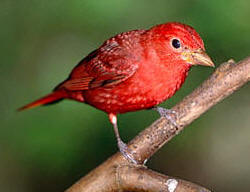 Summer tanager, Pirunga rubra Summer tanager, Pirunga rubra
Western tanager, Piranga ludoviciana
Yellow-winged tanager, Thraupis abbas
BACK TO BIRD GUIDE LIST
Thrushes and Swallows:
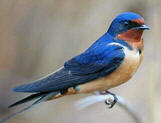 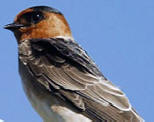 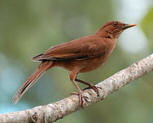 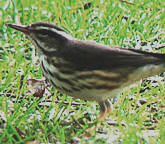 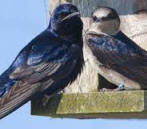
Barn swallow Cave swallow Clay colored robin Louisiana Waterthrush Purple Martin
* Barn swallow, Hirundo rustica. A distinctive worldwide spread passerine bird with blue upperparts, a long, deeply forked tail and curved, pointed wings. Enjoys feeding on insects caught while it flies. Barn swallows tend to be comfortable around humans and perches in electric cables and man-made structures. Enjoys open space areas as its habitat.
* Cave swallow, Petrochelidon fulva - Its located mainly in central south Mexico, with isolated permanent groups in Chiapas and upper Yucatán peninsula where the Cave shallow flocks prefer cenotes and caves as their habitats, which they shared with bats in Yucatan. This shallow visits the Hacienda Chichen pool area almost daily for a drink of water. Easy to recognize for their brown tangerine forefront and throat with blue gray upper-parts, tail is square and bill very small. Feeds on small insects. Nests in tunnels and caves. (center left photo above text)
* Clay colored robin, Turdus greyi, ( X'Kok in Maya ) This songbird has a rather low-pitched and with a slow steady tempo, consists of many slurred musical notes, often repeated irregularly. Loves to feed on ants and other insects, also small fruit seeds found in the ground. (center, third photo above text)
Cliff swallow, Petrochelidon pyrrhonota it is from same family as the cave swallow found in Hacienda Chichen Bird Refuge and gardens all year round though it is a migratory bird. Females lay 2 to 4 pale blue eggs with red-brown and gray markings between March and July and are known to eject parasite bird eggs from their nests.
Gray-cheeked thrush, Turdus
* Louisiana waterthrush, Seiurus motacilla, this migrant small thrush has plain brown back and white underparts streaked with black. The flanks and undertail are buff, with a strong white flared supercilium, and the legs are bright pink. The male's song is a musical with distinctive descending notes. (center right photo above text)
Northern rough-winged swallow, Stelgidopteryx serripennis
* Pulple martins, Progne subis, the largest swallow in North America. Males have dark, glossy blue-black plumage; females and immature birds are duller above and grayish below. The purple martin is an extremely popular and well-known bird. Known for its series of chortles, gurgles, and slightly harsher croaking singing notes and calls.
(side right top photo above)
Ridgway’s rough-winged swallow, Stelgidopteryx ridgway - "Cutzam" in Maya. This brown-backed, dusky-throated little swallow prefers open areas, including those in human-made structures. Females nest singly or in small colonies in burrows or crevices. It feeds over water, more than most species of swallows, and occasionally picks floating insects from the water surface.
Swainson’s thrush, Catharus ustulatus, these birds migrate to southern Mexico, and as far south as Argentina. Swainson's thrush tends to keep away from noisy areas and human contact.
Tree swallow, Tachycineta bicolor
Wood thrush, Hylocichla mustelina
BACK TO BIRD GUIDE LIST
Tinamous:
Thicket Tinamou, Crypturellus cinnamomeus
BACK TO BIRD GUIDE LIST
Tityra and Becard:
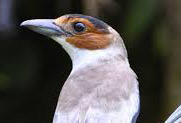 Black crowned tityra, Tityra inquisitor (Pelan K'euel in Maya) Black-Crowned Tityra is a widely distributed bird in the Yucatan. Belongs to the Tyrannidae family. The black crowned tityra is the only Tityra species in which the male lacks any red area on the face and bill, while the females show large amounts of red on their faces of any of the three species in this genus. Black crowned tityra, Tityra inquisitor (Pelan K'euel in Maya) Black-Crowned Tityra is a widely distributed bird in the Yucatan. Belongs to the Tyrannidae family. The black crowned tityra is the only Tityra species in which the male lacks any red area on the face and bill, while the females show large amounts of red on their faces of any of the three species in this genus.
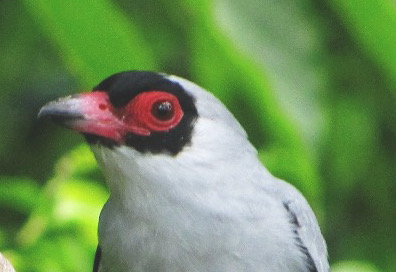 Mask tityra, Tityra semifasciata, (Pelan K'euel in Maya) The Masked Tityra is found at Hacienda Chichen Resort’s Bird Refuge and gardens. traditionally placed on the Tityridae family, order Passeriformes. The male's body’s plumage are whitish with black facial mask and crown, plus a distinctive red ring mark around eyes and bill. The females are browner over the upper parts. Mask tityra, Tityra semifasciata, (Pelan K'euel in Maya) The Masked Tityra is found at Hacienda Chichen Resort’s Bird Refuge and gardens. traditionally placed on the Tityridae family, order Passeriformes. The male's body’s plumage are whitish with black facial mask and crown, plus a distinctive red ring mark around eyes and bill. The females are browner over the upper parts.
UPDATE: Recent genetic evidence supports the claim that Rose-throated Becards should be in their own family. We are leaving them with the Tityra, as many birders still regard these two groups together.
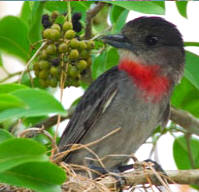 Rose-throated becard, Pachyramphus aglaiae, is a winter migratory resident easy to spot at Hacienda Chichen Bird Refuge and beautiful gardens. Rose-throated becards are small flycatcher birds with gray upperparts, large head with a black feather cap, a fairly large pale rose-red throat spot, and pale gray under-parts. Rose throated becards love to catch insects in flight and eat larvae, fruits and small wild berries. Their flight is often for short distances with rapid shallow wing-beats. Rose-throated becard lays two to six white with brown blotches eggs and builds large foot-long globular nests in spring. Rose-throated becard, Pachyramphus aglaiae, is a winter migratory resident easy to spot at Hacienda Chichen Bird Refuge and beautiful gardens. Rose-throated becards are small flycatcher birds with gray upperparts, large head with a black feather cap, a fairly large pale rose-red throat spot, and pale gray under-parts. Rose throated becards love to catch insects in flight and eat larvae, fruits and small wild berries. Their flight is often for short distances with rapid shallow wing-beats. Rose-throated becard lays two to six white with brown blotches eggs and builds large foot-long globular nests in spring.
Rose-throated becard, Piranga roseogularis, is found in shrubby second growth forest. Enjoy's plucking fruit and frequenting semi-open edges of gardens.
BACK TO BIRD GUIDE LIST
Toucan and Aracari:
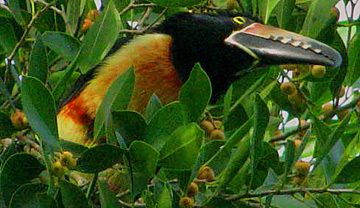 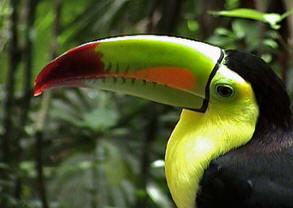
Collared Aracari, Pteroglossus torquatus Toucan, Keel-billed, Ramphastos sufuratus
Keel-billed Toucan, also known as the Rainbow billed toucan, inhabits the tropical forests in Colombia to the Yucatan in Mexico. Toucans, Ramphastos sulfuratus, are beautiful, colorful birds so attractive and elegant, they area a joy to observe in the wild. A Keel toucan has black body, belly, and tail plumage, blue eyeliner, and a yellow or white bib shaped chest. Feeds on fruits and seeds, enjoys flying in small groups to perch atop lush tree canopy. The large beak is light in weight for it is built as a sponge soft bone covered in keratin a very waxy protein. The Keel-billed toucan roosts in a hollow old tree branch with other toucans of the flock. Very sociable bird that is a joy to watch in the wild as it flies with his small flock from tree top to tree top. (picture: top right)
BACK TO BIRD GUIDE LIST
Turkey:
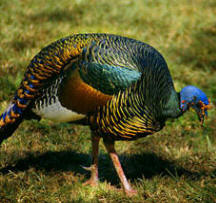 Ocellated Turkey, Agriocharis ocellata, this wild bird is one of the many endemic bird species of Yucatan and it is protected in our Nature Reserve, is known to the Maya as the grand "Kutz". Males have a lovely plumage of iridescent golden yellow, violent, indigo blue, metallic greens and white; their head and neck color has deep hues of blue and violet with protuberances like a domestic turkey. Their tails have a semi-circular pattern near the end of the feathers. Ocellated Turkey, Agriocharis ocellata, this wild bird is one of the many endemic bird species of Yucatan and it is protected in our Nature Reserve, is known to the Maya as the grand "Kutz". Males have a lovely plumage of iridescent golden yellow, violent, indigo blue, metallic greens and white; their head and neck color has deep hues of blue and violet with protuberances like a domestic turkey. Their tails have a semi-circular pattern near the end of the feathers.
Found only in Yucatan, the Oscellated turkey feeds on seeds, shoots, or insects, lives in small family groups within deciduous low bush forest. A ground dweller that can not be domesticated and nests in dense forest spots, sleeping at tree top branches. Mayan families enjoy to eat these shy and easy to disrupt birds.
BACK TO BIRD GUIDE LIST
Trogons:
Trogon family of birds has 36 species that reside in tropical forests worldwide. This bird species loves to perch and has only one family, the Trogonidae. The word "trogon" in Greek means "nibbling" and it refers to the birds building tree nest holes. Two trogon bird species are found at Hacienda Chichen, Chichen Itza, Yucatan, Mexico, both reside at the hotel's Bird Refuge and can be seen eating insects and fruits perching serene on their arboreal habitats; they are generally sedentary.
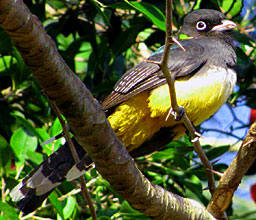 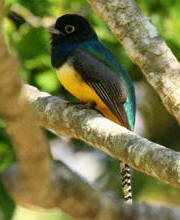
Black-headed Trogon, Trogon Melanocephalus. Violaceus trogon, Trogon violaceus
BACK TO BIRD GUIDE LIST
Vireo Birds:
Males of most vireo bird species are persistent singers. Vireos feed mainly on small insects, fruits and seeds.
Lesser greenlet. vireo, Hylophilus decurtatus
Mangrove vireo, Vireo pallens
Red-eyed vireo, Vireo olivaceus
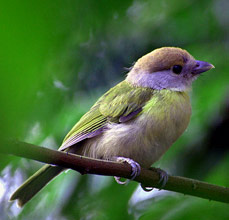
Rufous-browed peppershike
Cyclarhis gujanensis
Warbling vireo, Vireo gilvus
White-eyed vireo, Vireo griseus,
Yellow-green vireo, Vireo flavoviridis,
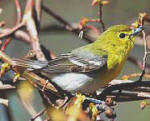
Yellow-throated vireo, Vireo flavifrons
Yucatan vireo, Vireo magister,
BACK TO BIRD GUIDE LIST
Vultures::
American Black vulture, Coragyps atratus
Turkey vulture, Cathartes aura
BACK TO BIRD GUIDE LIST
Wabler Birds:
American redstart warbler, Setophaga ruticilla
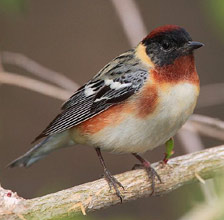
Bay-breasted warbler
Dendroic castaneaa
Blue-winged warbler, Vermivora pinus
Black-and-white warbler, Mniotilta varia
Blackpoll warbler, Dendroica straita
Black-throated blue warbler, Dendroica caerulescens
Black-throated green warbler, Dendroica virens
Black and white warbler, Mniotita varia
Cape May warbler, Dendroica tigrina
Cerulean warbler, Dendroica cerulea
Chestnut-sided warbler, Dendroica pensylvanica
Common yellowthroat warbler, Geothlypis trichas
Kentucky warbler, Oporomis formosus
Louisiana waterthush, Seiurus motacilla, this migrant small thrush has plain brown back and white underparts streaked with black. The flanks and undertail are buff, with a strong white flared supercilium, and the legs are bright pink. The male's song is a musical with distinctive descending notes.
Gray-crowned yellow-throat, Geothlypis poliocephala
Hooded warbler, Wilsonia citrina
Magnolia warbler, Dendroica magnolia
Northern Parula, Perula americana
Northern waterthrush warbler, Parkesia noveboracensis
Ovenbird warbler, Seiurus aurocapillus
Palm warbler, Dendroica palmarum
Prairie warbler, Dendroica discolor
Prothonotary warbler, Protonotaria citrea
Tennessee warbler, Vermivora peregrina
Yellow warbler, Dendroica petechia aestiva
Yellow-breasted Chat, Icteria virens
Yellow-rumped warbler, Dendroica coronata
Yellow-throated warbler, Dendroica dominica,
BACK TO BIRD GUIDE LIST
Waxwings:
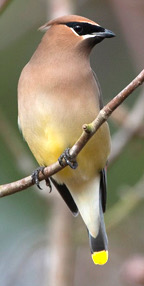 Cedar waxwing, Bombycilla cedrorum, the only one of out of the three species of waxwings found at the Hacienda Chichen Resort’s Bird Refuge and gardens. It is only found in the New World. An immigrating bird, this species flocks fly looking for their favorite variety of berries, especially cedar berry. They have a distinctive high pitched trill as their flight call. Summer berry production triggers their nesting. They are highly gregarious. They have a medium-sized bodies with large crested heads and short. square tails that have a yellow tip. Cedar waxwing, Bombycilla cedrorum, the only one of out of the three species of waxwings found at the Hacienda Chichen Resort’s Bird Refuge and gardens. It is only found in the New World. An immigrating bird, this species flocks fly looking for their favorite variety of berries, especially cedar berry. They have a distinctive high pitched trill as their flight call. Summer berry production triggers their nesting. They are highly gregarious. They have a medium-sized bodies with large crested heads and short. square tails that have a yellow tip.
BACK TO BIRD GUIDE LIST
Woodpeckers and Woodcreeper Birds:
All woodpeckers and woodcreeper birds are called Colonte in Maya, at Hacienda Chichen private Bird Refuge and Wildlife Sanctuary in Chichen Itza, Yucatan, Mexico. Woodpeckers are a family of near-passerine birds Picidae. Most species live in woodlands habitats, feeding on insects and some small seeds. There are ten species of this genera residing in our gardens and Maya jungle. The Ivory-billed woodpecker is extinct in many parts of the world but has been observed in our property by renown bird-watchers such as Barbara MacKinnon and naturalist Jim Conrad.
Woodcreepers are passerine birds endemic to the Neotropics with their distinct family Dendrocolaptidae; they keep an upright vertical posture thanks to their stiff tail vanes. Woodcreepers feed mainly on insects and like woodpeckers they are arboreal cavity-nesting birds. Woodpeckers and woodcreepers have stiffened tails, used as prop, crucial for their climbing and foraging. View our photo album of both species bellow to identify which bird you have observed while staying with us:
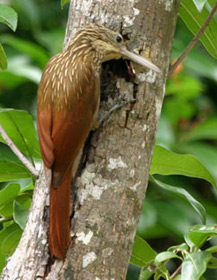 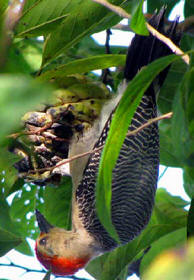 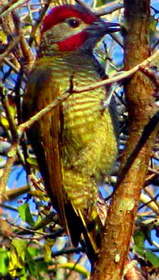 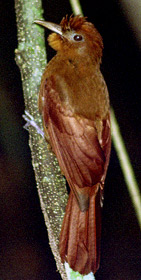
Ivory-billed woodcreeper Golden-fronted woodpecker Golden olive woodpecker Ruddy woodcreeper
Xiphorhynchus flavigaste Centurus aurifrons Piculus Rubiginodud Dendrocincla homochroa
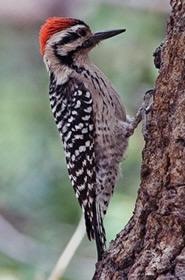 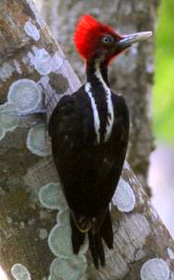 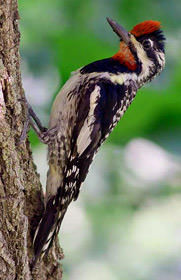 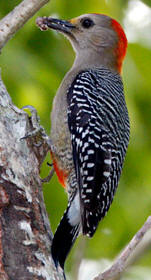
Ladder-backed woodpecker Pale-billed woodpecker Yellow-bellied sapsucker Yucatan woodpecker
Picoides scalaris Campephilus guatemalensis Spyrapicus varius Melanerpes pygmaeus
Lineated woodpecker, Dryocopus lineatus
Olivaceous woodcreeper, Sittasomus griseicapillus
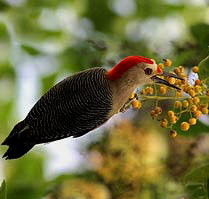 Yucatan woodpecker, Melanerpes pygmaeous, is known to the Maya people as "Ch'ujum." This woodpecker is endemic to the Yucatan, living in low forest with plenty of insects to feed; loves the coconut plantation at Hacienda Chichen, an area that many families of Yucatan woodpeckers reside year round. Nests and breeds in old hollow wood branches where up to four eggs may be incubated for 23 days. Fascinating birds have black and white strips backs and wings plumage, and a pale yellow/brown body; the forehead yellow spot is clearly mark and the crest is vivid red. A large strong peak with a very long retractable tongue supported by a strong tendon attached to the skull of these birds help them feed. Yucatan woodpecker, Melanerpes pygmaeous, is known to the Maya people as "Ch'ujum." This woodpecker is endemic to the Yucatan, living in low forest with plenty of insects to feed; loves the coconut plantation at Hacienda Chichen, an area that many families of Yucatan woodpeckers reside year round. Nests and breeds in old hollow wood branches where up to four eggs may be incubated for 23 days. Fascinating birds have black and white strips backs and wings plumage, and a pale yellow/brown body; the forehead yellow spot is clearly mark and the crest is vivid red. A large strong peak with a very long retractable tongue supported by a strong tendon attached to the skull of these birds help them feed.
BACK TO BIRD GUIDE LIST
Wrens:
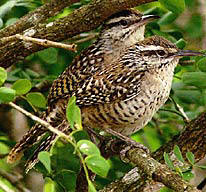 Carolina wren, thryothorus ludovicianus Carolina wren, thryothorus ludovicianus
House wren, Troplodytes aedon
Spot-breasted wren, Thryothorus maculipectus
Southern house wren, Troglodytes aedon
White-browed wren, thryothorus albinucha
White-bellied wren, Uropsila leucogastra
Yucatan wren, Campylorhynchus yucatanicus, called " Yan coti" in Maya (see Yucatan endemic birds).
BACK TO BIRD GUIDE LIST
Yucatan Endemic Birds: look also for each bird group
Many endemic birds found in the Yucatan Peninsula can be observed at
the Hacienda Chichen Bird Refuge and Maya Jungle Reserve:
Our own Yucatan Bird List is grouped in a manner that most bird lovers will easily recognize.
The reason for so many Yucatan endemics bird species can be easy understand:
Unique species tend to evolve on islands where gene flow from surrounding populations is cut off, allowing island-bound birds to evolve to their own local conditions. The Yucatan Peninsula is an "ecological island." It is surrounded by water in the east, west and north, and, in the south, the moist, lush forests and marshes found there are ecologically very different from the arid north. To Yucatan birds adapted to dry, scrubby environments, the tall, humid forests of the south are nothing less than ecological walls.
About 50% of all of Mexico's bird species are found in the Yucatan Peninsula, with 58% of all North American birds found here. 128 bird species, or so, from North America regularly overwinter in the Yucatan; while some 54 bird species pass through the Yucatan during spring and/or fall migration, nesting many times in the peninsula or farther north, and overwinter here or farther south. About 58 species are considered vagrants or occasional visitors. From October to May each year is the best time to come enjoy not only Yucatan’s endemic bird species but also migratory birds. Hacienda Chichen Resort’s private Bird Refuge and Maya Jungle Reserve offers birders and all guests alike, a fantastic bird population with over 157 bird species observed during such months each year. The birds on this page are some of the birds you can observe and enjoy not only in our Bird Refuge but from your own private cottage-room terrace and the hotel’s lush tropical gardens.
There are a hundred or so of non-endemic bird species also observed as regular residents at the Bird Refuge at Hacienda Chichen Bird Refuge Chichen Itza, Yucatan, Mexico; all of them have found in this sustainable hotel property a peaceful safe heaven to nest, breed, and enjoy a natural safe habitat. Guests and local workers have learned to admire and protect these creatures. We wish to share Yucatan's vast animal kingdom with future generations; therefore, caring and protecting their habitat is our mission and joy.
Wildlife Protection and Reforestation: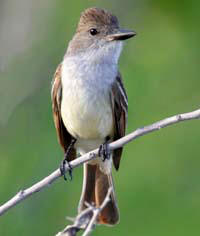
Hacienda Chichen Eco-Spa Resort is truly an unique eco-hotel and Colonial historic landmark in the mist of Chichen Itza's Mayan temples, Yucatan, Mexico. With a high environmental awareness commitment and strong ecological safe practices, Hacienda Chichen is a Nature Lover destination, especially for birders and bird-watching aficionados hoping to observe hundred of colorful wild birds joyfully singing and moving in such closeness that a pair of binoculars may not be needed to fully appreciate each bird. Genuinely committed to Sustainable Tourism in Yucatan, this acclaimed Green Spa Jungle Resort offers native eco-cultural activities to all its guests since 2003, when Mr. Bruce Gordon and Mrs. Belisa Barbachano took over the operation of this beautiful hacienda and boutique green hotel. Mr. Bruce Gordon directs all ecological ventures of the hotel such as its Nature & Wildlife Conservation, and Reforestation programs; he also oversees the Hacienda Chichen's green hospitality practices and policies. Under his direction, the Hacienda Chichen is committed to taking active measures to preserve, conserve, and enrich the flora and fauna habitats, aiming to increase diversity and protect the habitat of endemic wildlife. His responsible actions have stopped the illegal hunters of white deer and other endangered animal species (fauna) for entering the property; thus, increasing the safety of many endangered endemic species in the region, including families of kinkajous, oscillated turkeys, and white tail deer. Mr. Gordon and his forest-guards have planted over 2,500 indigenous hardwood trees in the property and reclaimed over 80 acres of unauthorized farmed land. staff; thus, increasing the natural joy of learning about each other; this interaction enriches the local community at the same time that the community enriches the visitors’ cultural experience and knowledge.
The property of Hacienda Chichen sits in the heart of the ancient Maya city of Chichen Itza, Yucatan, Mexico. For four generations, the owners have kept this property as a green Maya Jungle Resort with utmost environmental care, protecting Yucatan's fauna (animals) and endemic flora (plants) within their vast private Maya Jungle Reserve Eco-Spa Resort's property; respecting not only Yucatan's historical legacy, its impressive Maya and Colonial cultural value, but the hospitality green vision and sustainable social mission that has made Hacienda Chichen an innovating eco-cultural destination where travelers can experience authentic Mayan cultural traditions.
Mexican sheartail, Dorich eliza, endemic emerald green humming bird, "Dzunum" in Maya.
Ocellated Turkey, Meleagris ocellata – endemic species
Yucatan bobwhite, Colinus nigrogularis, "Bech" in Maya.
Yucatan flycatcher, Myiarchus yucatanesis, known in Maya as a " X'takay "
Yucatan Jay, Cyanocorax yucatanicus, endemic.
Yucatan nightjar, Caprimulgus badius, called "Box Pujuy" in Maya
Yucatan amazon parrot or Yellow lored amazon, Amazona xantholora, "T'uut" in Maya
Yucatan poorwill, Nyctiphrynus yucatanius, called "Chac Pujuy" in Maya, this endemic mid-size nightjar belongs to the Caprimulgidae family
Yucatan Quail, Colinus virginianus
Yucatan vireo, Vireo magister
Yucatan woodpecker, Melanerpes pygmaeous, is known to the Maya people as "Ch'ujum."
Yucatan wren, Campylorhynchus yucatanicus, called " Yan coti" in Maya.
BACK TO BIRD GUIDE LIST
Visit Our Sponsored Sites:

|

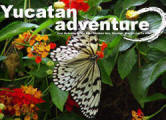




 Blue Bunting
Blue Bunting






















 Lesser Goldfinch
Lesser Goldfinch










































































 Blue-gray tanager,
Blue-gray tanager,








 Black crowned tityra,
Black crowned tityra, 









 Cedar waxwing,
Cedar waxwing, 













